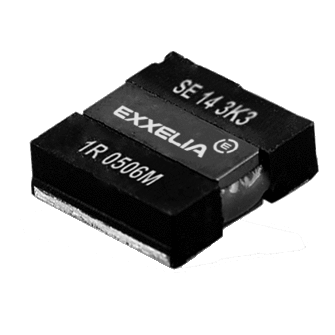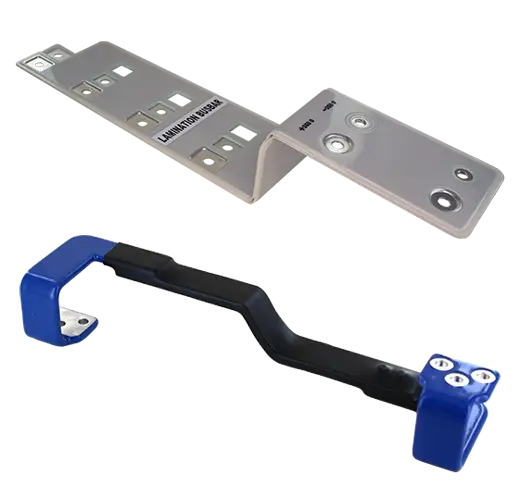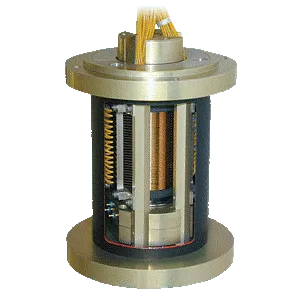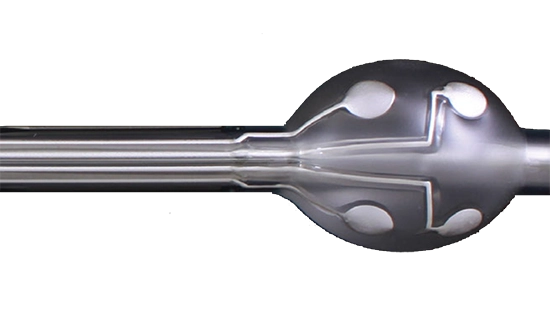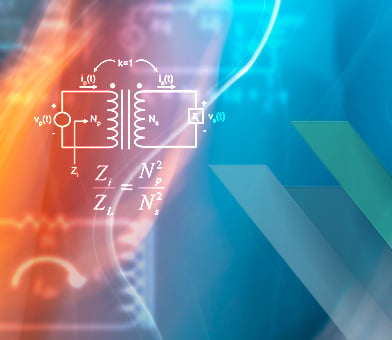

Ressources
Les catalogues disponibles incluent tous les condensateurs, filtres, composants magnétiques, résistances, capteurs de position et collecteurs tournants. Des brochures par type d'application sont également disponibles pour les principaux marchés d'Exxelia.
Découvrez Exxelia ABC Software, nos capacités de pointe en matière de modélisation RF et de simulation électromagnétique. Cet outil spécialisé analyse le comportement en fréquence des condensateurs, effectue une analyse de conception haute fidélité et optimise les performances. Exxelia ABC facilite les études paramétriques avancées.
Enfin, notre FAQ couvre des sujets tels que les critères de sélection des composants, la gestion thermique, les processus de haute fiabilité, les capacités de conception personnalisée et les protocoles de test.
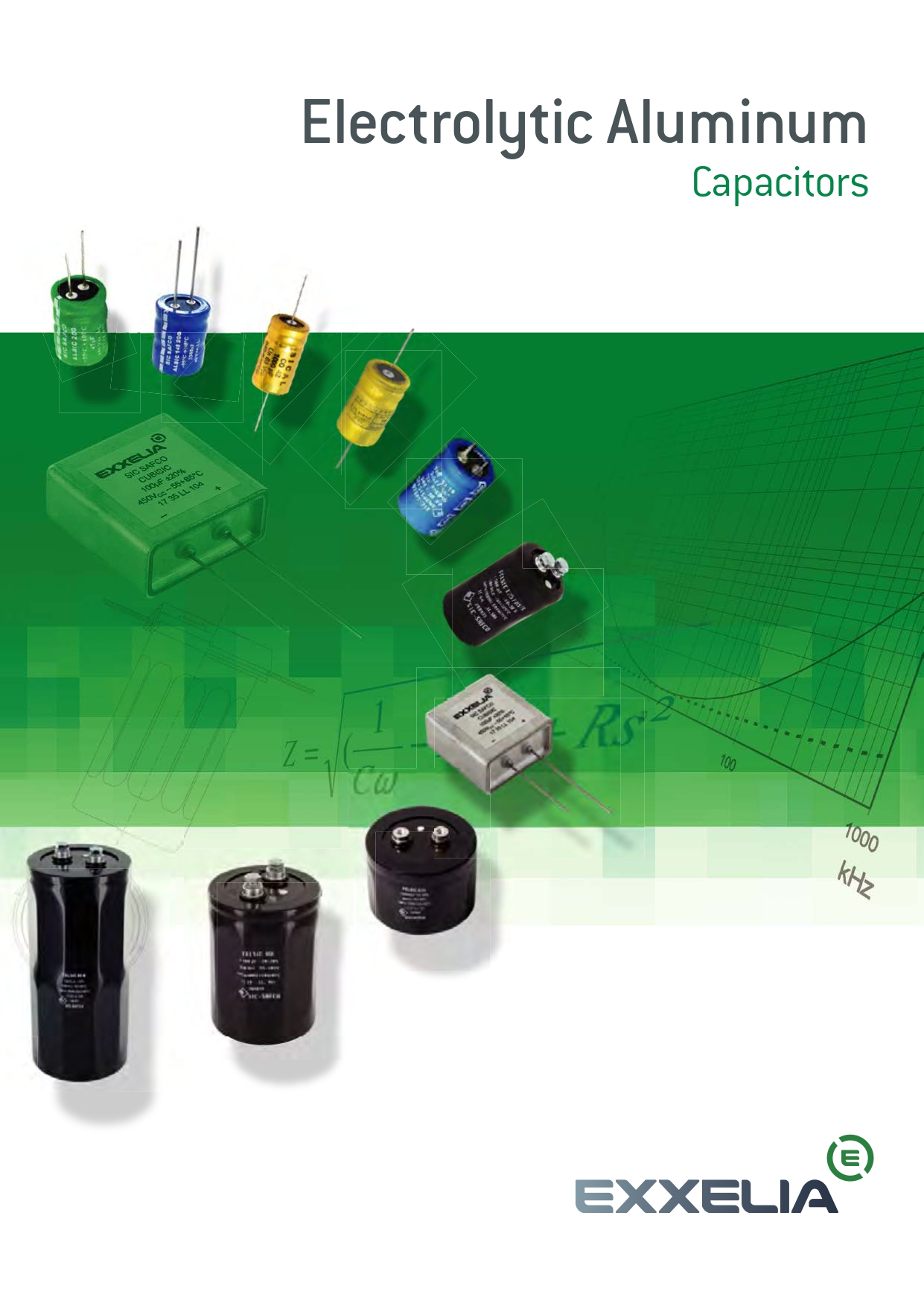
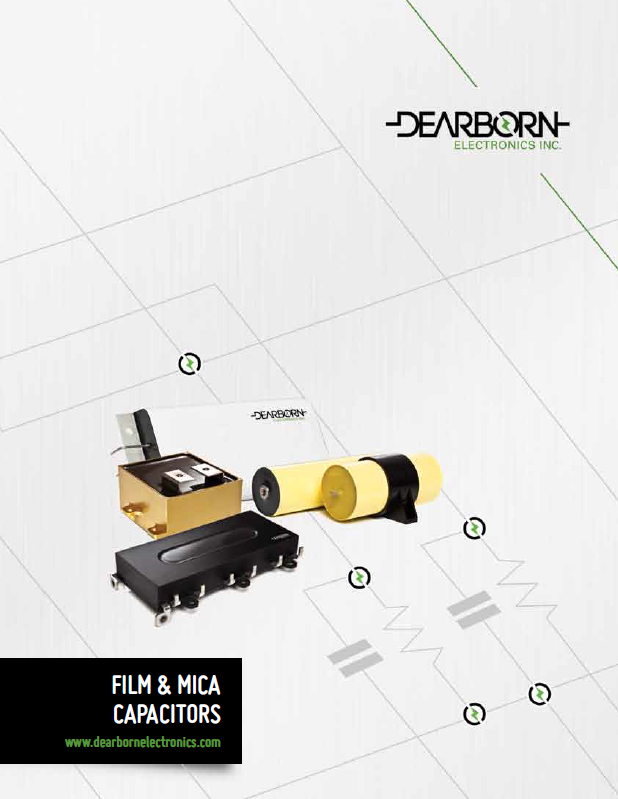
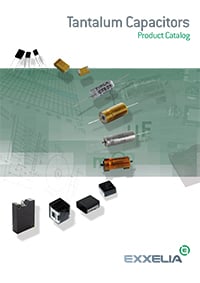



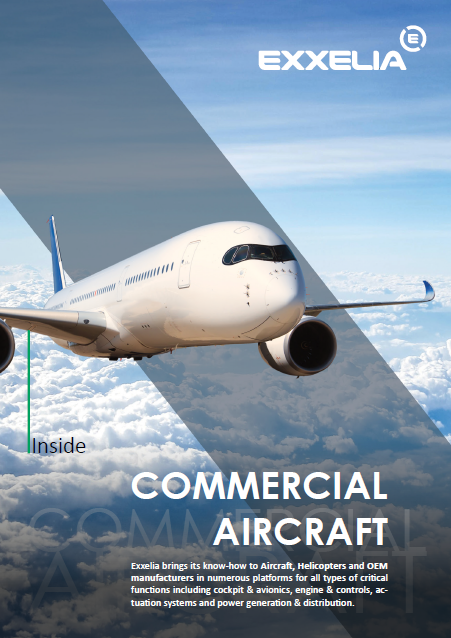
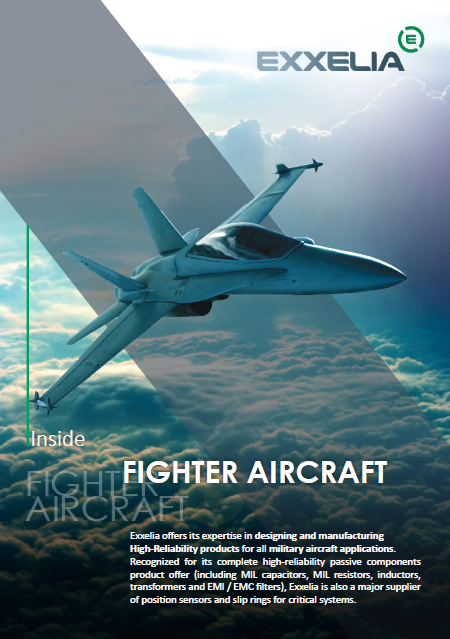
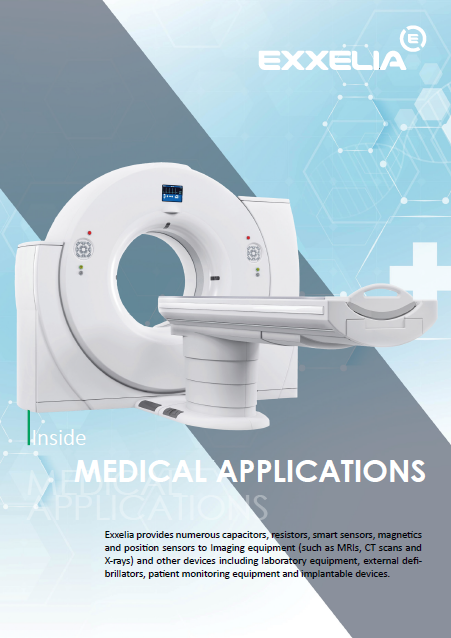
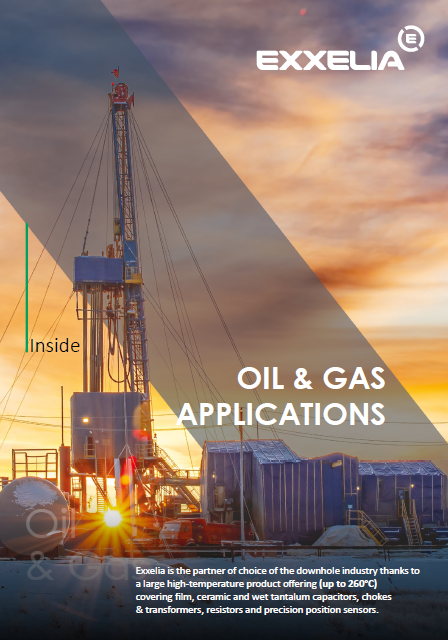
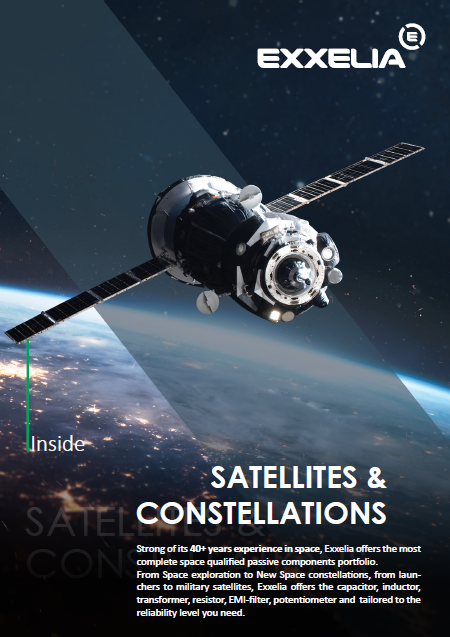

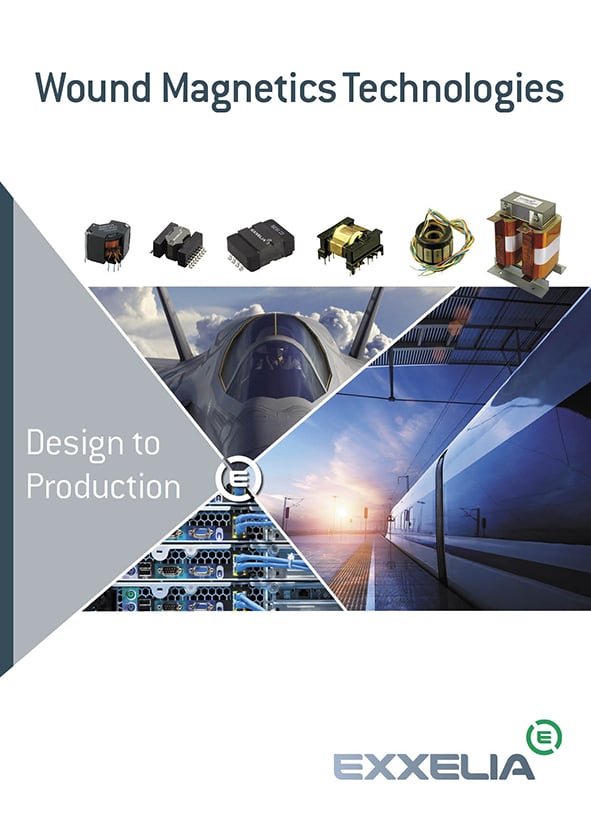


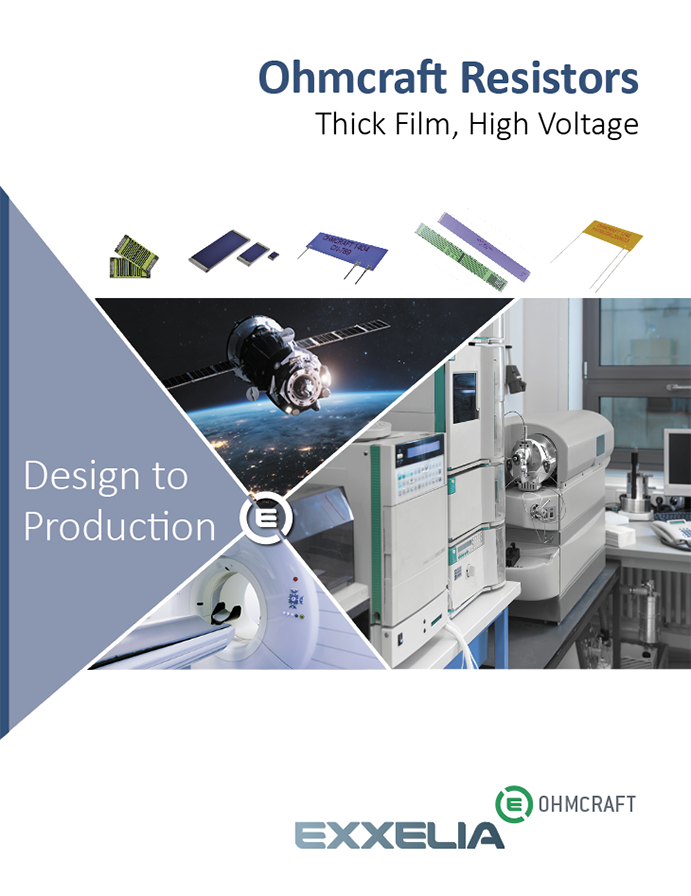
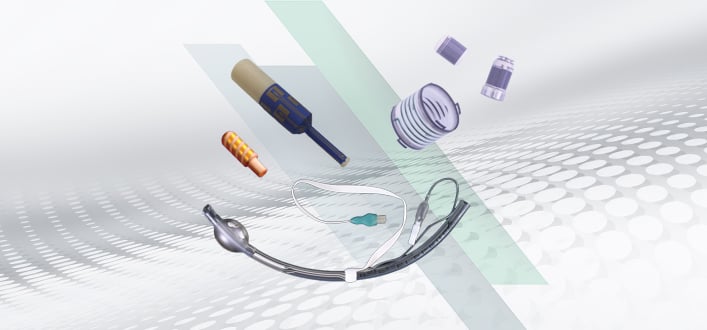
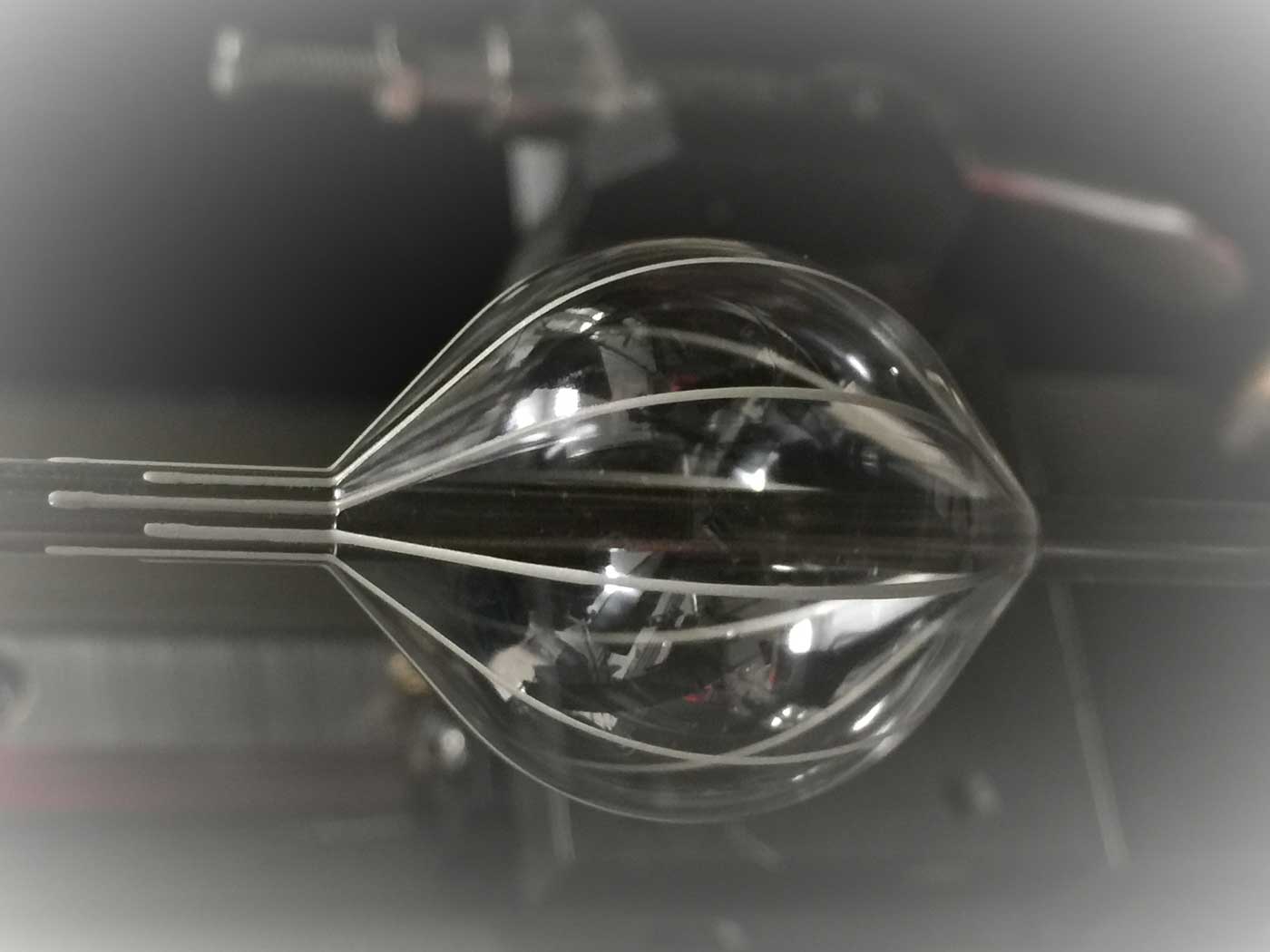
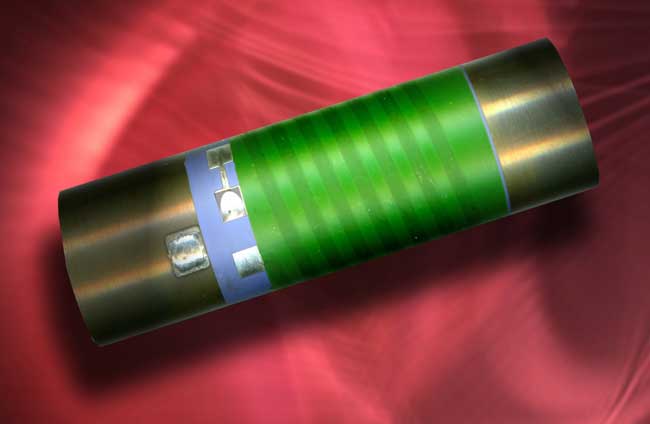

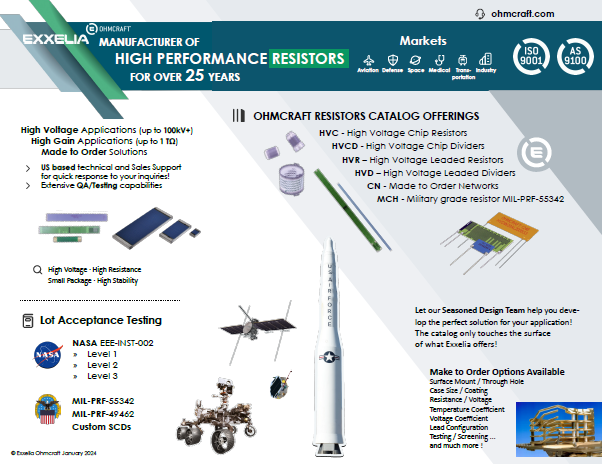
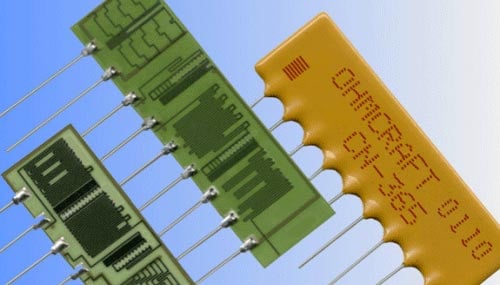
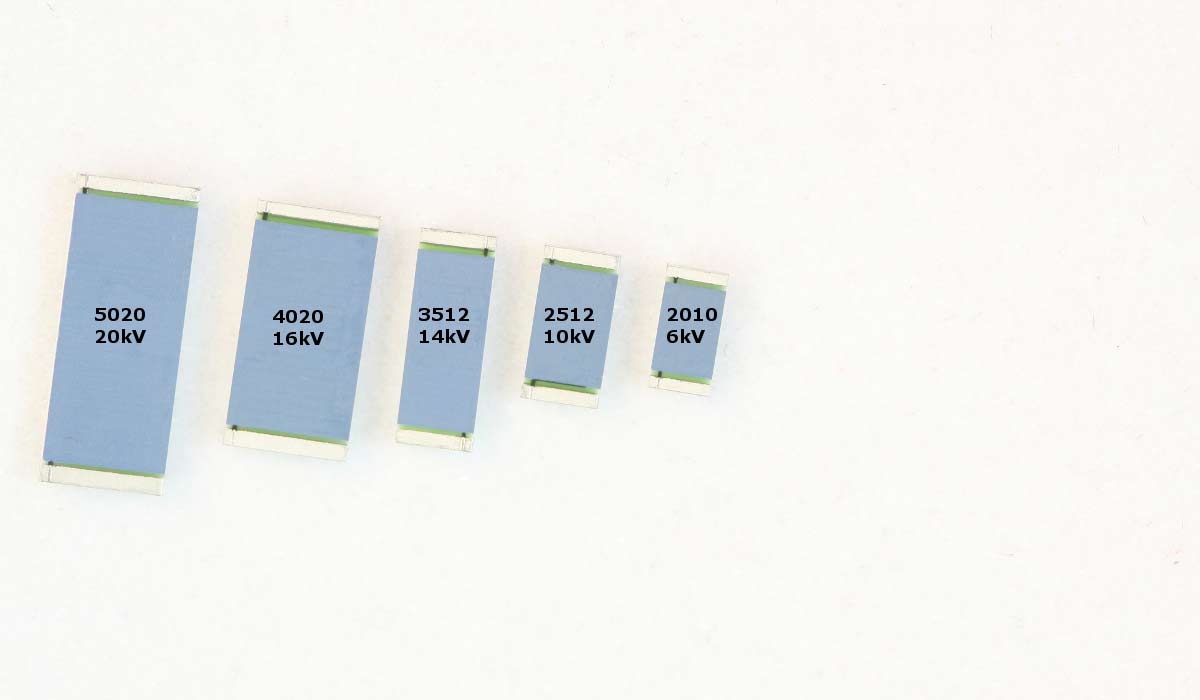


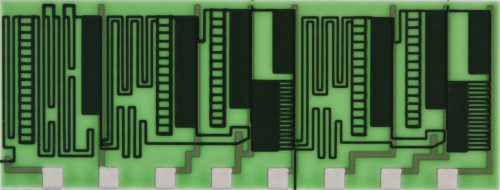

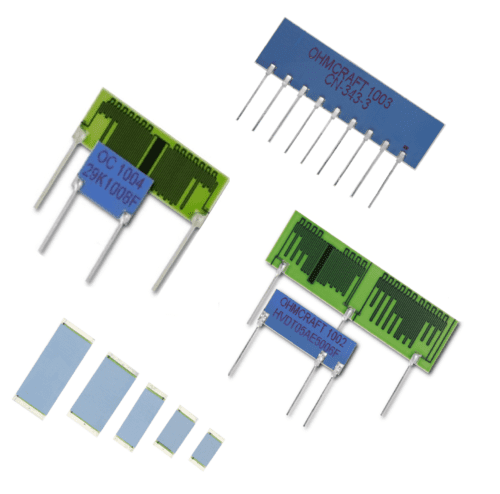
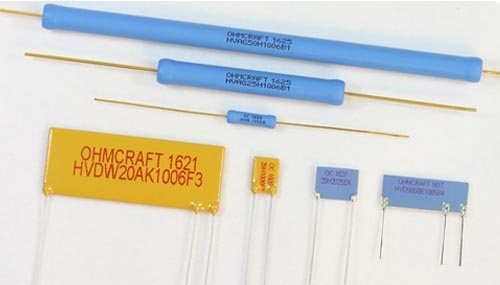
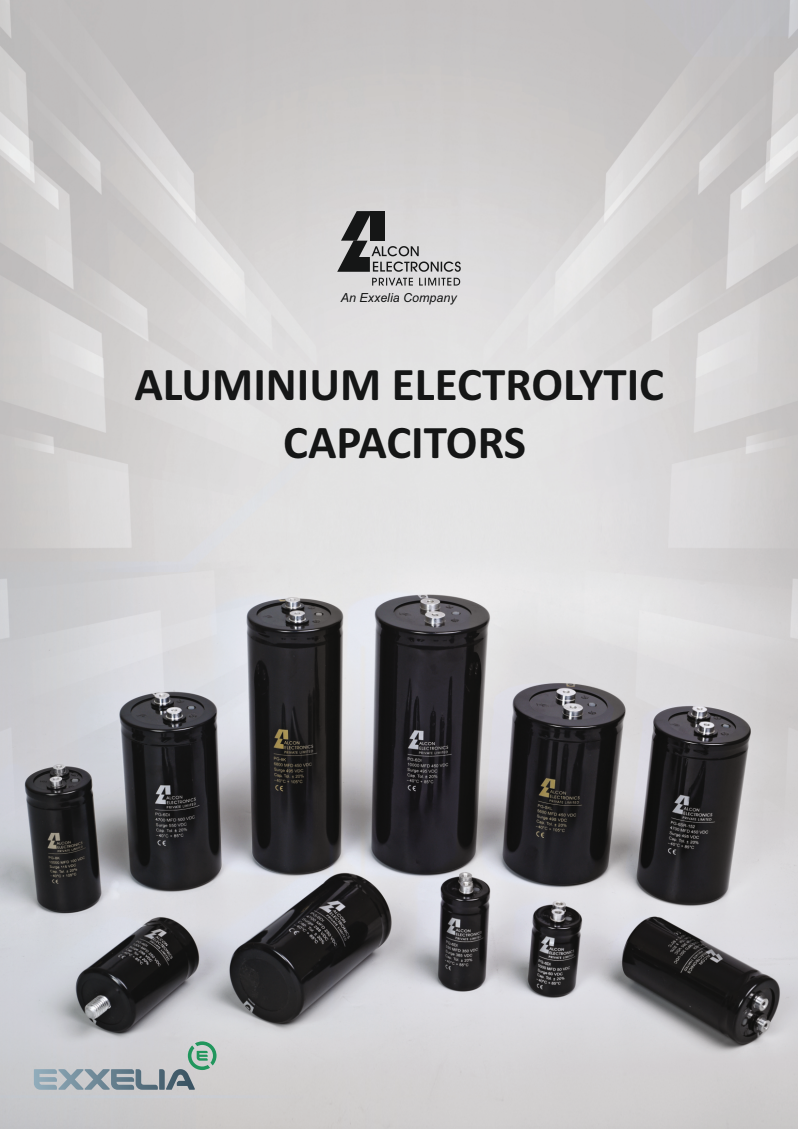

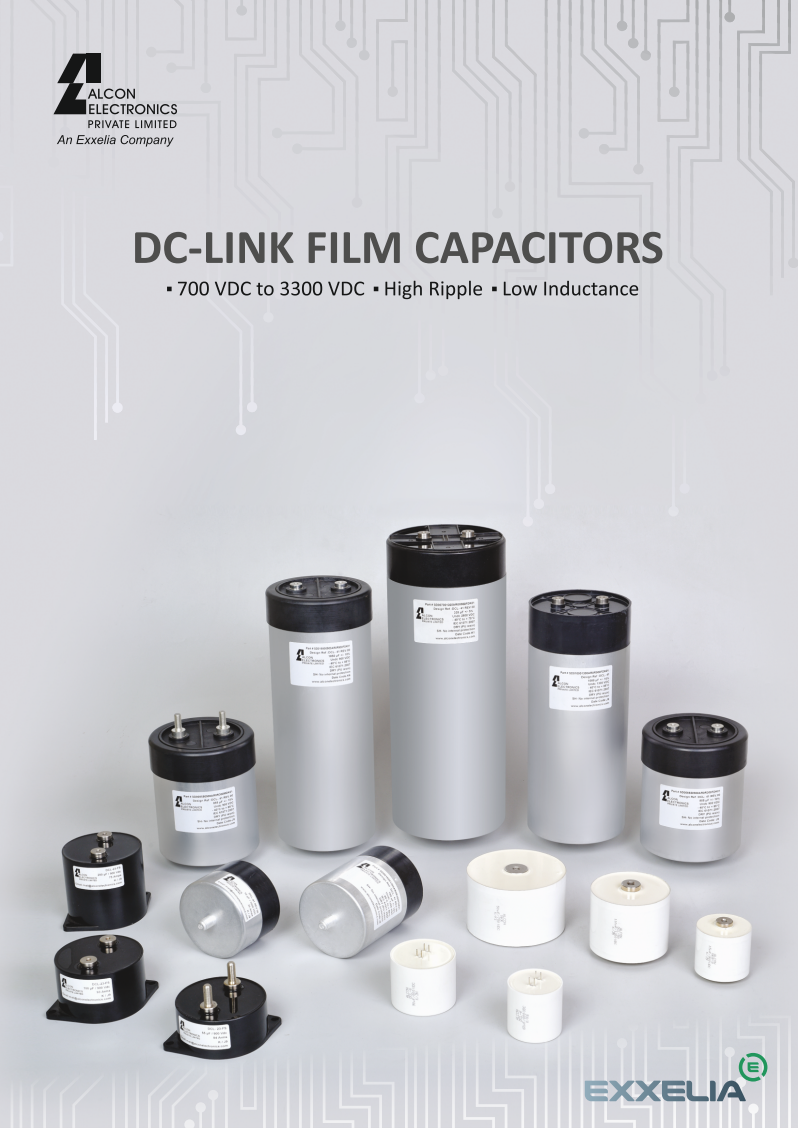
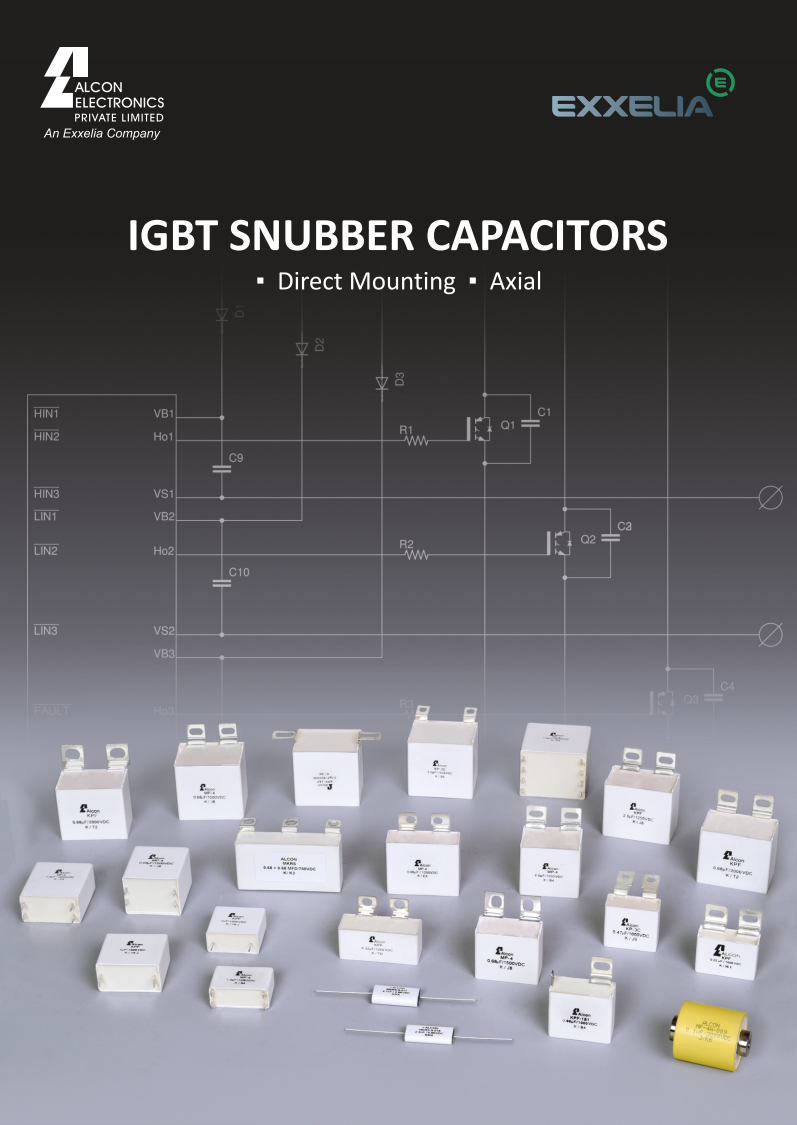
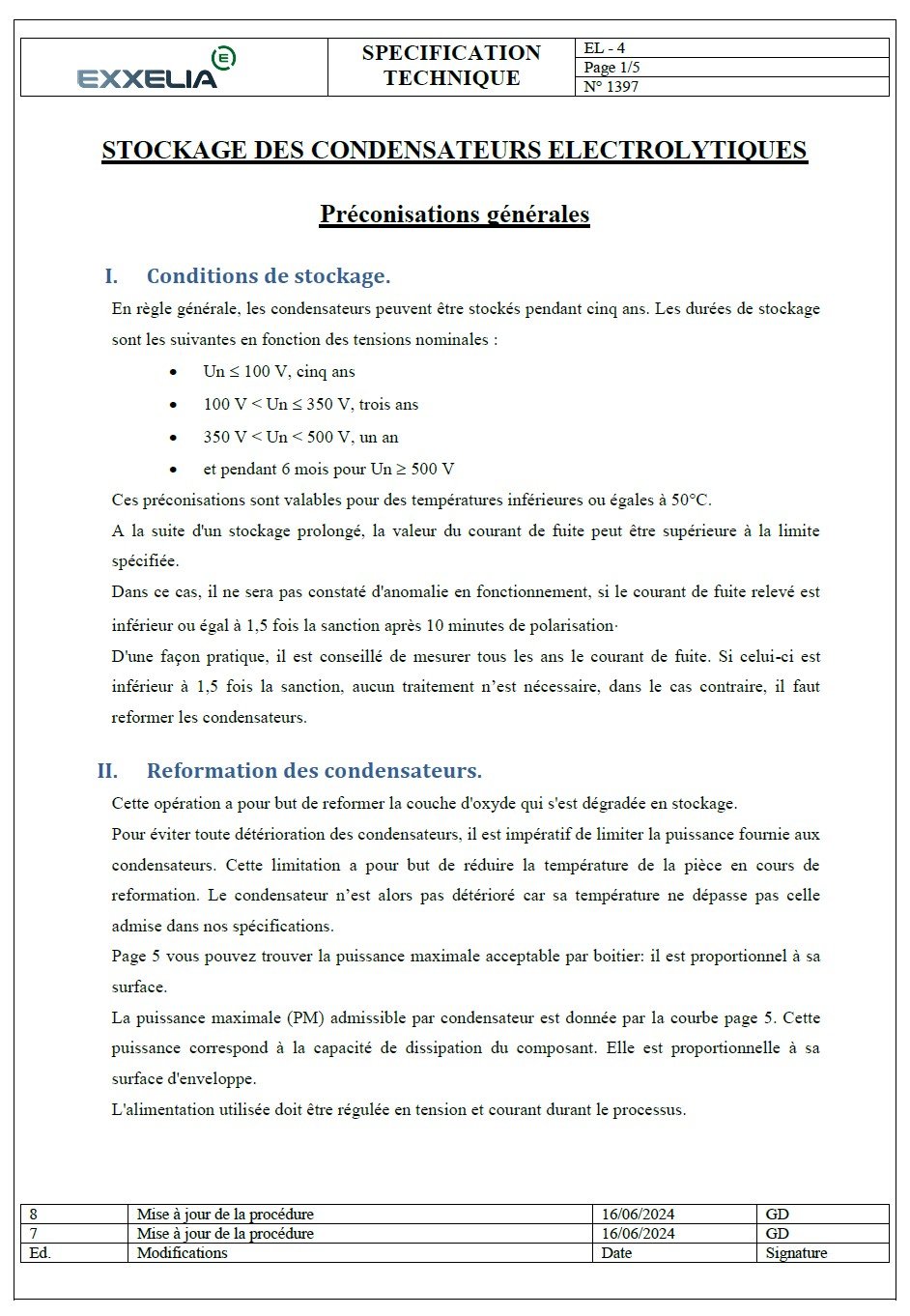
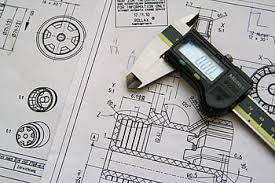



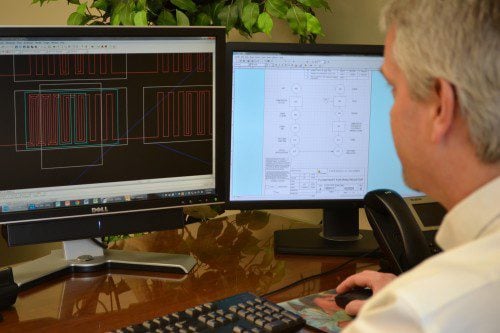
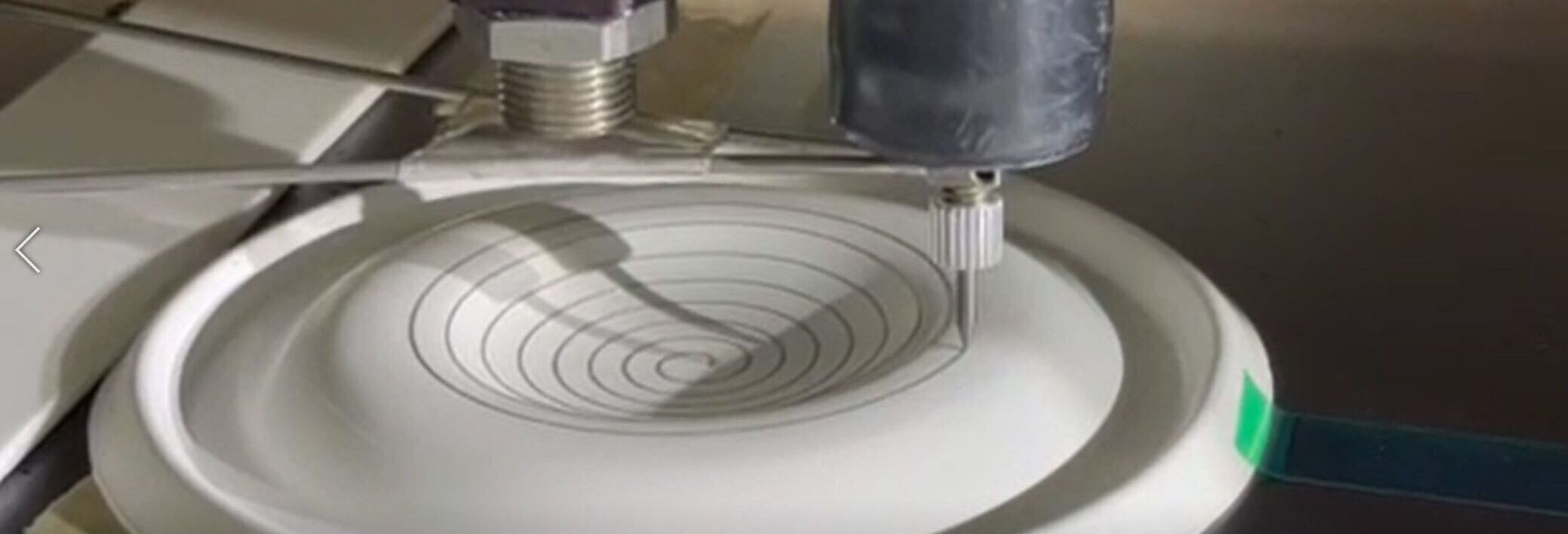
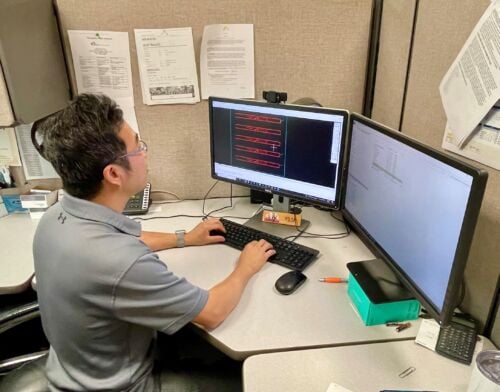


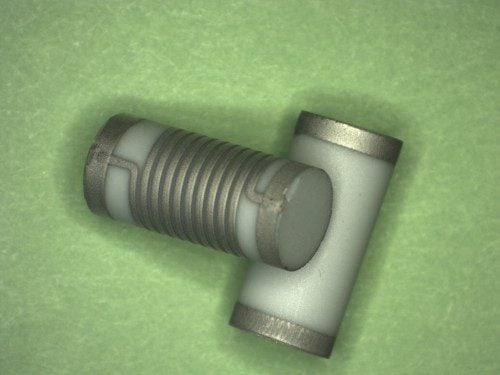
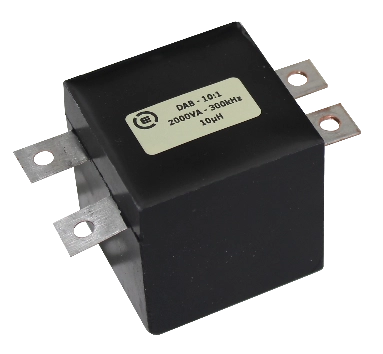

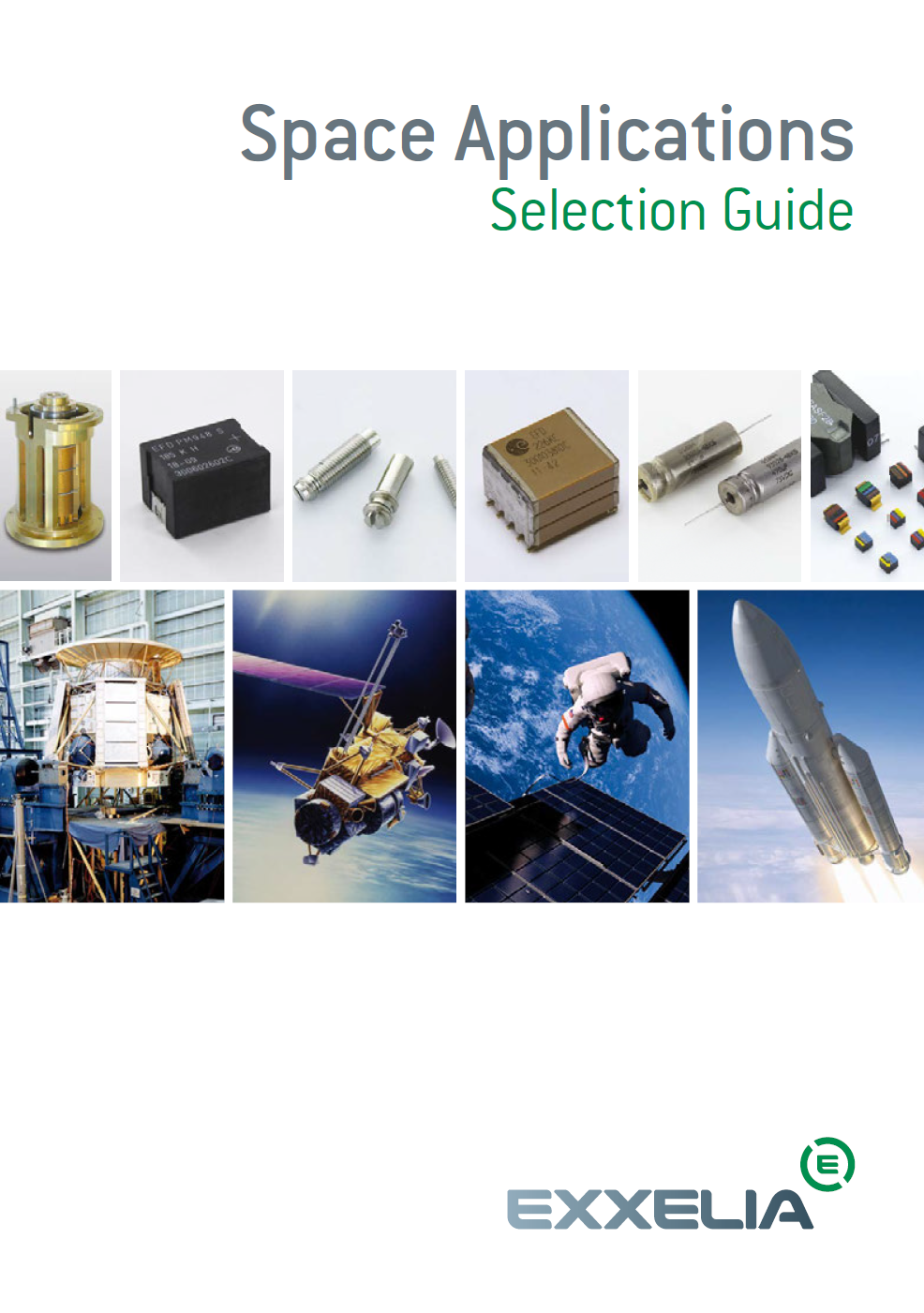

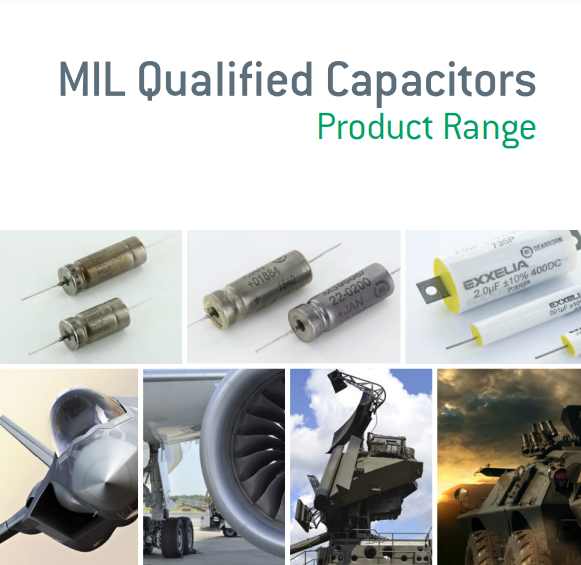
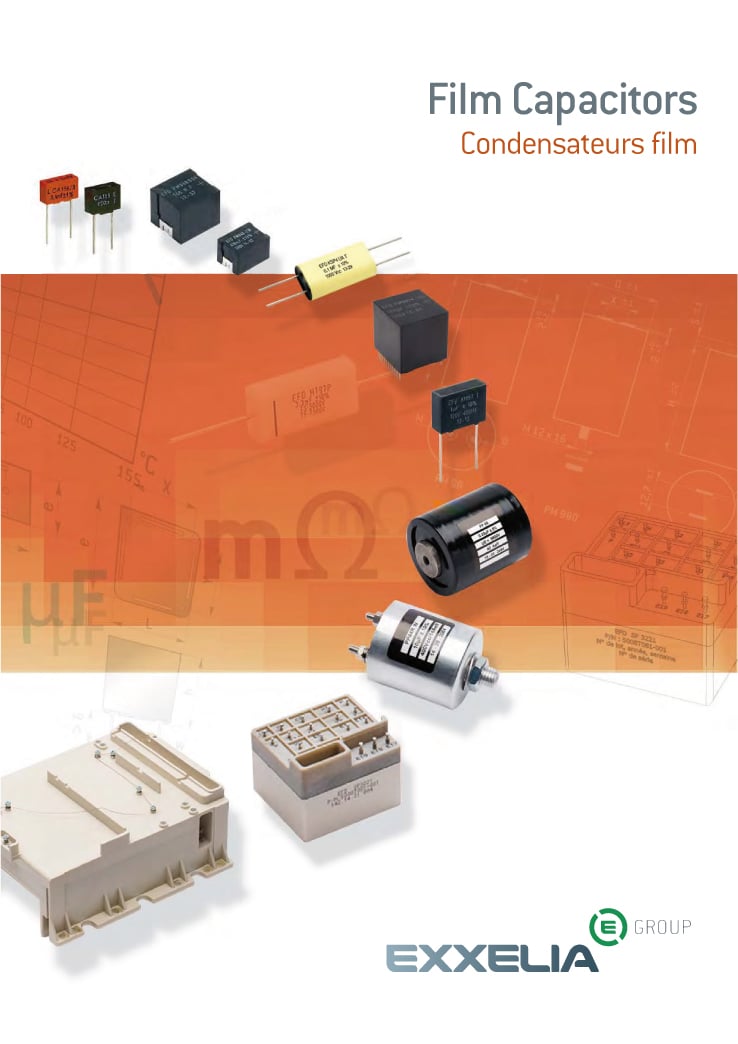

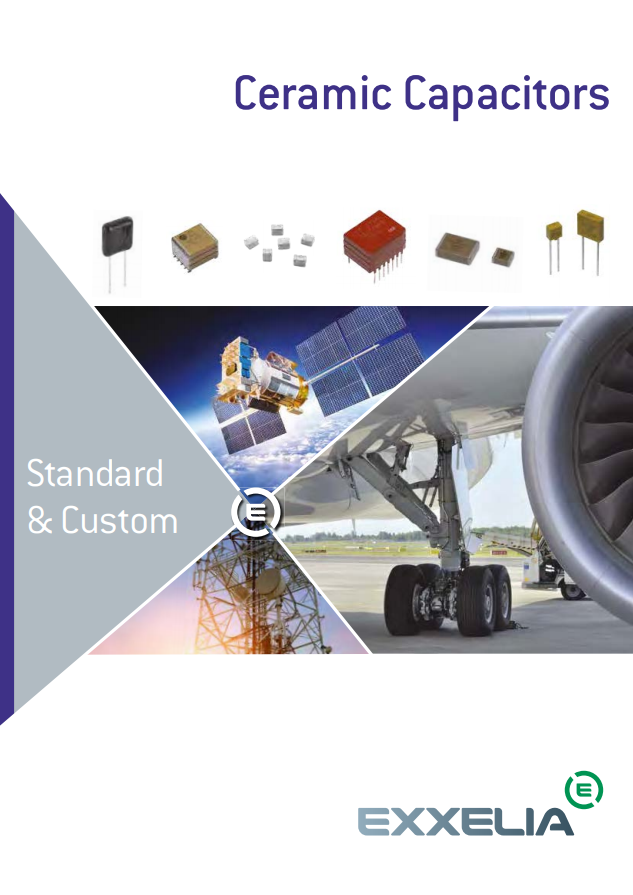

Nos guides
Modèles RF


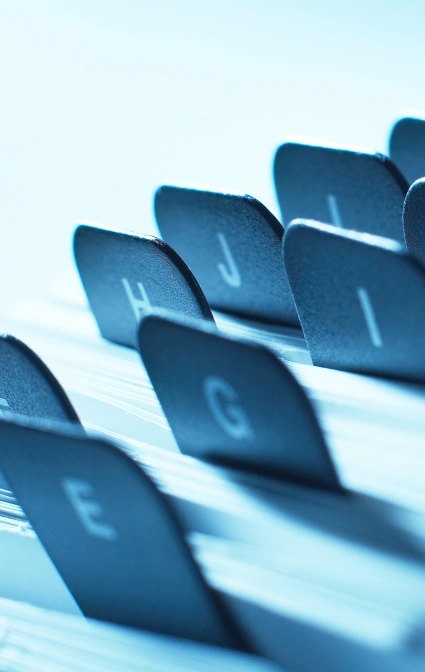
Questions Fréquemment Posées
Filtre à trois sections composé de deux condensateurs de traversée à la masse et d'une inductance en série entre eux. Le filtre Pi est généralement symétrique, comme tous les filtres Pi de ce catalogue, mais les circonstances justifient parfois l'utilisation de circuits Pi asymétriques. Un filtre Pi a des caractéristiques d'atténuation qui augmentent de 60 dB par décennie depuis sa fréquence de coupure jusqu'à la fréquence où il présente une atténuation minimale de 80 dB. Il maintient ce niveau à des fréquences plus élevées.
Les filtres Pi-Only sont le choix idéal lorsque des niveaux élevés d'atténuation sont nécessaires et que les impédances d'entrée et de sortie sont similaires.
Les condensateurs tantale liquide se distinguent par une densité énergétique beaucoup plus élevée, atteignant 1000 J/dm³, contre seulement 12 J/dm³ pour les condensateurs tantale solide. Ils offrent également des tensions nominales supérieures, allant jusqu'à 150 V, et peuvent fonctionner à des températures beaucoup plus élevées, jusqu'à 200°C.
D’un autre côté, les condensateurs tantale solide présentent des avantages tels que la miniaturisation, une haute stabilité à long terme et une très faible résistance série équivalente (ESR), les rendant idéaux pour des applications nécessitant des composants compacts et fiables.
Ces condensateurs offrent une charge très élevée par unité de volume, une longue durée de vie et une grande fiabilité. Ils sont utilisés dans les biens de consommation et dans des niches plus spécialisées telles que les véhicules spatiaux, l'électronique aéronautique, l'armement et le transport ferroviaire. Exxelia développe des condensateurs au tantale solides et humides.
Un condensateur au tantale est un type particulier de condensateur électrolytique. Il est fabriqué à partir d'un métal appelé tantale, d'où son nom. Le tantale fait office d'anode. Le condensateur lui-même est recouvert d'une fine couche d'oxyde, qui lui permet de jouer le rôle de diélectrique. Il est entouré d'une cathode conductrice. L'un des principaux avantages des condensateurs au tantale est que leur conception permet d'avoir une couche très fine de diélectrique, ce qui permet d'obtenir une capacité plus élevée que d'autres types de condensateurs fabriqués à partir d'autres types de matériaux. Ces types de condensateurs sont généralement polarisés, ce qui signifie qu'en pratique, ils ne peuvent être connectés qu'à une alimentation en courant continu qui a été conçue en respectant la polarité appropriée des bornes. Ils présentent une excellente stabilité dans le temps et des caractéristiques de fréquence supérieures à celles d'autres types de condensateurs similaires fabriqués à partir de matériaux différents.
Les condensateurs standard en mica argenté sont normalement conçus pour supporter des tensions de 100 à 1000 volts. Les applications d'émetteurs RF à haute tension peuvent exiger des tolérances plus élevées. Les condensateurs en mica sont disponibles pour des tensions allant jusqu'à 20kV.
Notre équipe d'ingénieurs experts peut créer le condensateur en mica avec les caractéristiques dont vous avez besoin. Envoyez-nous votre dessin ou votre fichier et nous travaillerons avec vous pour fabriquer la taille, le type de fil et la capacité que vous souhaitez.
Les condensateurs au mica argent offrent une stabilité supérieure et une faible perte lorsqu'ils sont utilisés dans des circuits de puissance RF qui nécessitent des plages de pico farad (pF) et de nano farad (nF) faibles. Les anciens condensateurs argent-mica étaient fabriqués en couches de mica et d'argent, mais ces couches laissaient de la place pour des espaces d'air qui réduisaient la stabilité et pouvaient également créer des ruptures de tension dans l'assemblage.
La fabrication moderne utilise de l'argent plaqué sur des couches de mica, éliminant ainsi les espaces. Lorsque le nombre de couches souhaité est atteint, l'assemblage est recouvert d'une résine époxy ou céramique. Le revêtement réduit la rupture des couches et protège l'assemblage de l'humidité et des particules qui pourraient interférer avec la valeur de la capacité.
Les condensateurs au mica sont utiles dans les circuits de filtrage des ondulations et se retrouvent souvent dans les circuits à constante de temps, de couplage ou de résonance. Outre les circuits radio, ils sont utilisés dans les émetteurs de télévision et les circuits d'amplification de la télévision par câble. Le Mica est également un choix supérieur dans l'inversion de haute tension et la conversion d'énergie pour les applications de snubber absorbant l'énergie avec des capacités allant jusqu'à 10 nF.
Cet isolant minéral naturel possède des propriétés diélectriques exceptionnelles qui sont idéales pour les condensateurs à longue durée de vie et à haute stabilité, avec une faible perte à toutes les fréquences et une rigidité diélectrique élevée. Ce type de condensateur est particulièrement utilisé pour les applications à haute fréquence et les lignes à retard, les circuits oscillants, les dispositifs d'émission et les calibrateurs.
La technologie des condensateurs diélectriques au mica permet de concevoir plusieurs applications personnalisées, notamment
- Condensateurs haute tension (jusqu'à 50 kV)
- Condensateurs haute température (jusqu'à 250°C)
- Condensateurs de précision (jusqu'à ± 0,1 %)
- Condensateurs à haute stabilité (- 20 + 30 ppm/°C)
- Condensateurs haute fréquence (jusqu'à plusieurs GHz).
La plupart de ces condensateurs sont fabriqués conformément aux spécifications NF-C-83120, MIL-C-5 et MIL-PRF-39001.
Les condensateurs au mica se distinguent par les caractéristiques suivantes :
- Performance en température
- Faible perte à toutes les fréquences
- Résistance diélectrique élevée
- Stabilité dans le temps
Si vous avez besoin d'informations complémentaires, consultez la liste des représentants commerciaux d'Exxelia présents dans le monde entier. Vous pouvez également consulter la liste de nos distributeurs pour obtenir plus d'informations sur les distributeurs les plus proches de chez vous.
N'hésitez pas à nous contacter si vous avez des questions supplémentaires concernant notre société ou les produits et services que nous fournissons. Votre navigateur Internet vous permet de nous contacter de différentes manières, notamment pour demander un devis, nous envoyer un fichier ou un dessin ou nous envoyer un courrier électronique. Nous attendons avec impatience votre réponse.
Les condensateurs haute tension peuvent être fabriqués à partir de différents types de matériaux. Les condensateurs en céramique haute tension et les condensateurs à film polyester métallisé ne sont que deux des principaux types de condensateurs. Ils se distinguent par quelques caractéristiques différentes :
Temps de charge - Même si différents types de technologie sont utilisés pour le fonctionnement des condensateurs haute tension, les temps de décharge et de charge sont très comparables à ceux des condensateurs ordinaires. Ces temps de charge sont possibles grâce à la faible résistance interne des matériaux utilisés.
Puissance spécifique - Une autre caractéristique principale qui distingue ces types de condensateurs est la puissance spécifique, ce qui signifie qu'ils ont une puissance spécifique jusqu'à dix fois supérieure à celle des batteries ordinaires.
Durée de vie et sécurité - Les condensateurs haute tension sont beaucoup plus sûrs que les condensateurs et les batteries traditionnels, même lorsqu'ils sont maltraités. Une batterie traditionnelle, par exemple, est connue pour exploser complètement en cas de court-circuit, de chaleur excessive ou d'autres types de situations.
Chargement illimité - Les condensateurs haute tension peuvent également être chargés et déchargés un nombre pratiquement illimité de fois. Les condensateurs et les batteries traditionnels ne peuvent être chargés qu'environ 500 fois avant de perdre une partie de leur puissance initiale.
Pour ces raisons, les condensateurs haute tension fabriqués à partir de tous les types de matériaux sont très utiles dans les situations où l'énergie doit être stockée et libérée fréquemment.
Nos condensateurs haute tension sont spécifiquement conçus pour pouvoir supporter une charge électrique plus importante que celle offerte par les autres types de condensateurs. Ils utilisent deux mécanismes principaux pour stocker l'énergie transmise, contrairement à la méthode diélectrique conventionnelle utilisée avec d'autres types de condensateurs. La première méthode principale utilisée pour stocker l'électricité est appelée capacité à double couche, tandis que la seconde est appelée pseudo-capacité. Ces méthodes sont respectivement d'origine électrostatique et électrochimique, ce qui permet aux condensateurs haute tension de combiner les méthodes de stockage d'énergie des condensateurs normaux avec les méthodes utilisées pendant le fonctionnement d'une batterie normale.
L'objectif principal des condensateurs haute température est de permettre une performance stable des équipements électriques à des températures élevées. Ils sont également très utilisés dans les applications qui requièrent un haut niveau de fiabilité. Bien qu'il existe une grande variété de condensateurs différents et de types de technologies disponibles en fonction des besoins de la situation, seuls quelques condensateurs peuvent fonctionner de manière fiable lorsque les températures deviennent élevées.
Les condensateurs haute température fabriqués à partir de matériaux tels que la céramique ou le tantale sont généralement utilisés lorsqu'une application commence à fonctionner à une température proche ou supérieure à 350 degrés Fahrenheit.
Les condensateurs céramiques et les condensateurs mica haute température sont souvent utilisés dans des situations qui nécessitent une tension ou une puissance plus élevée que la normale. En raison de leur mode de construction, ils peuvent offrir un faible ESR et d'excellentes capacités de courant d'appel et d'ondulation que d'autres types de condensateurs ne peuvent pas offrir. Le seul inconvénient est qu'ils ont tendance à être physiquement plus grands que les autres types de condensateurs.
L'industrie automobile est un autre domaine où les condensateurs haute température sont nécessaires. Les conditions de température peuvent varier considérablement en fonction de la zone de la voiture dont il s'agit. Les systèmes de freinage, le moteur et la transmission sont souvent les zones où la température est la plus élevée.
Les produits en tantale à haute température sont conçus pour être utilisés dans des situations où l'on peut utiliser un équipement de forage au fond d'une mine, par exemple. Ils sont idéaux pour ce type d'entrée et de sortie en raison de leurs capacités de courant d'ondulation élevé. Ils sont également connus pour avoir l'avantage supplémentaire de valeurs de courant qui offrent des fuites plus faibles par rapport à d'autres types de technologies de condensateurs.
Les condensateurs haute température ont une grande variété d'utilisations différentes en fonction de l'industrie. Dans le domaine de l'avionique, par exemple, ils doivent remplir un grand nombre de tâches différentes. La température de fonctionnement des équipements avioniques peut varier considérablement en fonction de leur emplacement, allant de 130 degrés Fahrenheit à 390 degrés ou plus. C'est pourquoi ces types de condensateurs sont utilisés pour alimenter des équipements électroniques tels que les commandes de moteur, les systèmes d'atterrissage, les pompes à carburant et bien d'autres encore. Les condensateurs haute température permettent de s'assurer que ces types d'équipement peuvent à la fois supporter les cycles de chaleur importants et avoir une longue durée de vie.
Quel que soit le type d'application, il est toujours important d'examiner attentivement le type de condensateur que l'on choisit d'utiliser. Les condensateurs au tantale haute température et les condensateurs céramiques haute température ne sont que deux des principaux types de condensateurs disponibles pour fonctionner de manière fiable à des températures élevées, là où d'autres types de solutions pourraient échouer.
Exxelia fournit depuis longtemps des condensateurs haute température à diverses industries. Plusieurs diélectriques, tels que le plastique (PTFE ; PI ; & PEI), le mica reconstitué, l'aluminium électrolytique, le tantale et la céramique sont utilisés pour la fabrication de condensateurs haute température. Beaucoup sont imprégnés de résines solides thermodurcissables telles que l'époxy, le polyester ou le silicone.
Ces technologies offrent une très grande stabilité des caractéristiques mécaniques et électriques avec des capacités de température allant de -55°C à +230°C, en fonction de la technologie diélectrique, et certaines ne nécessitent pas de déclassement de tension. Les tensions nominales s'étendent de 30 VDC à 60 000 VDC avec des plages de capacité de 100pF à 30µF.
Filtre à trois sections composé de deux inductances connectées en série entre les bornes d'entrée et de sortie, avec un condensateur de traversée entre elles de la ligne à la masse. Le filtre en T est généralement symétrique (éléments inductifs identiques), mais les circonstances justifient parfois l'utilisation de circuits asymétriques. Un filtre en T a des caractéristiques d'atténuation qui augmentent de 60 dB depuis sa fréquence de coupure jusqu'à la fréquence où il présente une atténuation minimale de 60 dB.
Les filtres en T sont le choix idéal lorsque les impédances d'entrée et de sortie sont faibles.
Les puces de céramique sont créées à partir de liants et de solvants ajoutés à une poudre de céramique spécifique. La boue ainsi créée est séchée, formant une feuille ou un ruban de matériau céramique. La poudre de métal est mélangée à des solvants et à un matériau céramique supplémentaire pour créer une électrode liquide. Le liquide est ensuite imprimé sur la couche de céramique. Les couches de feuilles de céramique sont empilées et laminées pour former une structure solide.
La structure solide est découpée à la taille souhaitée. Une fois la découpe terminée, l'assemblage doit être cuit au four. La température utilisée dans le processus de cuisson est essentielle pour déterminer les caractéristiques du condensateur. Le processus est similaire pour les condensateurs à disque et à puce. Les condensateurs à disque utilisent de longs fils pour être montés sur les cartes de circuits imprimés. Les puces utilisent la technologie de montage en surface.
Deux éléments : un condensateur de traversée de la ligne à la masse et une inductance connectée en série entre les bornes d'entrée et de sortie.
L'élément capacitif peut être placé du côté de la ligne ou de la charge du filtre, ce qui en fait une entrée capacitive ou inductive. Son atténuation augmente de 40 dB par décade depuis sa fréquence de coupure jusqu'à la fréquence où il présente une atténuation minimale de 70 dB. Il maintient ce niveau à des fréquences plus élevées. Ils sont communément appelés filtres L :
- L1 indique que l'élément inductif se trouve à l'extrémité avec le col de montage fileté.
- L2 indique que l'élément capacitif se trouve à l'extrémité avec le col de montage fileté. Les filtres en L seulement ou LL sont utilisés lorsque la différence entre l'impédance de la ligne et celle de la charge est importante.
Il est préférable de placer l'élément inductif face à l'impédance la plus faible.
Il est constitué d'un seul élément : un condensateur de la ligne à la masse, avec un fil traversant reliant l'entrée à la sortie. Il présente des caractéristiques d'atténuation qui augmentent de 20 dB par décennie depuis sa fréquence de coupure jusqu'à la fréquence où il présente une atténuation minimale de 60 dB. Il conserve cette atténuation à des fréquences plus élevées. Un filtre à condensateur de traversée est généralement le meilleur choix pour filtrer les lignes qui présentent une impédance très élevée. Dans ce site web, un condensateur de traversée sera appelé filtre C.
Les filtres C uniquement sont le meilleur choix pour les lignes à très haute impédance.
Les gammes de condensateurs à film d'Exxelia comprennent un large éventail de conceptions personnalisées utilisant des technologies de pointe combinées aux derniers développements en matière de films diélectriques (y compris le polyester, le polypropylène, le PPS et le téflon). Des condensateurs Kraft/papier, à film et à film métallisé sont disponibles. Exxelia est ainsi en mesure de fournir des condensateurs à haute température, à haute tension, de précision avec des tolérances de ± ¼% et des performances exceptionnelles dans des environnements difficiles. Les condensateurs à film militaires sont testés et qualifiés selon les normes militaires, avec plus de 30 produits qualifiés militaires. Les condensateurs à film sont exceptionnels pour les applications d'impulsion/stockage, de liaison CC, de décharge d'énergie et les applications personnalisées.
Un large choix d'emballages est disponible, tels que les boîtiers en époxy pré-moulés, les boîtiers métalliques hermétiques et les enveloppes sous film. Exxelia continue de rechercher et de développer des condensateurs à film avec de nouvelles méthodes de fabrication de condensateurs afin de fournir des conceptions durables et des schémas d'emballage pour une utilisation environnementale spéciale.
Les condensateurs à film sont utilisés dans un grand nombre d'industries différentes, notamment dans la technologie et les applications militaires ainsi que dans l'industrie aérospatiale. Ceci est principalement dû au fait qu'ils ont une grande stabilité à long terme, qu'ils peuvent être produits à un prix relativement bas et qu'ils sont résistants à la chaleur.
L'une des principales caractéristiques de nos condensateurs à film réside dans le fait qu'ils ne sont pas polarisés. Grâce à cet élément de conception, ils peuvent être utilisés à la fois dans les applications de puissance et de signal en courant alternatif.
Ils sont également conçus pour avoir des valeurs de capacité de haute précision, ce qui signifie qu'ils peuvent conserver leur valeur pendant une période beaucoup plus longue que les condensateurs d'autres types. Le processus de vieillissement de ces types de condensateurs est généralement beaucoup plus lent qu'il ne le serait si un autre type de matériau était utilisé lors de la construction.
Les plastiques existent dans une gamme tellement large qu'ils peuvent répondre à la plupart de nos besoins techniques. Ils peuvent être utilisés dans des applications à haute température (téflon), dans le domaine de l'énergie (polypropylène), dans la conversion de l'énergie (polyester) et pour des fonctions nécessitant une grande stabilité (polycarbonate).
La gamme de produits s'étend des sorties de condensateurs pour la mise en œuvre sur des circuits imprimés, aux boîtiers métalliques avec sortie de borne pour les condensateurs de puissance dans les circuits câblés. Des dispositifs montés en surface (SMD) et des condensateurs film résistant à des températures élevées sont également fabriqués.
Nos condensateurs à film sont des types de condensateurs très spécifiques qui utilisent un film plastique fin comme élément diélectrique dans la configuration. La fine pellicule de plastique est fabriquée à l'aide d'un processus d'étirage de film technologiquement avancé. En fonction de la manière dont le condensateur doit fonctionner une fois qu'il est configuré, le matériau fin peut être laissé tel quel ou métallisé après le processus de fabrication.
Une fois le film ajouté, les électrodes sont placées dans l'assemblage, qui est monté dans un boîtier conçu pour protéger le condensateur d'une grande variété de facteurs environnementaux. En raison de leur incroyable stabilité, de leur faible coût de fabrication et de leur faible taux d'inductance, ces condensateurs sont utilisés dans de nombreux types d'applications. Attention, il existe sur Internet de nombreux types de condensateurs qualifiés de condensateurs à film qui changent simplement le type de matériau utilisé comme diélectrique.
Nos condensateurs à film polymère de haute qualité, nos condensateurs à film plastique, nos condensateurs à film de puissance et bien d'autres encore sont disponibles pour répondre à vos besoins. Le type de matériau spécifique qui sera utilisé lors de la création du condensateur variera en fonction de l'utilisation finale de l'appareil. Faites-nous savoir comment nous pouvons vous aider à répondre à vos besoins et à dépasser vos attentes.
Les deux principaux avantages des condensateurs à film résident dans le fait qu'ils ont une faible résistance série équivalente et une faible inductance propre. Grâce à ces propriétés, ils peuvent être conçus pour résister à des tensions de l'ordre du kilovolt. Les condensateurs de puissance à film poussent ces avantages encore plus loin et peuvent supporter une puissance réactive de plus de 200 volts ampères en charge.
Ces types d'avantages les rendent globalement très attrayants pour une grande variété de types d'industries dans le monde entier. Les coûts de construction peuvent être encore réduits grâce à l'utilisation de matériaux spéciaux.
Les modèles de simulation passifs et actifs Modelithics, basés sur des mesures, s'intègrent parfaitement aux derniers outils de simulation d'automatisation de la conception électronique (EDA), notamment Advanced Design System (ADS) de Keysight Technologies, NI AWR Design Environment/Microwave Office™, Genesys de Keysight Technologies, ANSYS® HFSS™ et Sonnet® .
Les modèles haute précision de Modelithics capturent les effets parasites et prédisent de manière fiable comment la performance des composants évolue en fonction de divers paramètres d'entrée évolutifs sur une plage de fréquence spécifiée. Les fonctions de mise à l'échelle et d'optimisation offrent une capacité d'analyse avancée et permettent aux concepteurs de circuits RF d'atteindre rapidement les objectifs de conception. Visitez la page des produits pour plus d'informations sur les avantages des modèles Modelithics. Notre objectif est de vous aider à réussir vos conceptions dès la première passe !
Trouvez les produits Exxelia sur Modelithics ici.
Un condensateur céramique de classe 1 est le meilleur choix pour les applications qui exigent de faibles pertes et une grande stabilité. Ce type de condensateur offre une capacité fiable dans la gamme de fréquence, de température et de tension désignée. Les séries de classe 2 offrent une capacité plus élevée, mais présentent des fluctuations plus importantes. La stabilité thermique varie de +/- 15 % ; ces séries doivent être utilisées dans des applications qui ne nécessitent pas une capacité exacte continue. Exxelia utilise NPO et P100 comme diélectriques de classe 1 ; et BX, 2C1 et X7R comme diélectriques de classe 2.
Les condensateurs de traversée de classe 1 offrent une réduction du bruit à haute fréquence et sont excellents pour la transmission des micro-ondes, les applications médicales et les lignes d'alimentation et de signaux à courant continu. La conception de la traversée utilise un fil de style axial pour les connexions.
Notre condensateur céramique multicouche (MLCC) est un condensateur à puce fabriqué avec des couches de céramique et de métal. Les couches alternées peuvent être construites jusqu'à la gamme de capacité souhaitée. L'épaisseur du diélectrique détermine la tension nominale. La capacité est déterminée en multipliant le nombre de couches par la surface active, puis par la constante diélectrique du matériau. Ce nombre est ensuite divisé par l'épaisseur diélectrique. La surface active est le chevauchement entre les électrodes.
Un condensateur doté d'une couche diélectrique plus épaisse supporte des tensions plus élevées qu'un condensateur doté d'une couche plus fine. Inversement, le diélectrique le plus fin aura une capacité nominale plus élevée. La conception du MLCC permet un gain de place significatif par rapport à d'autres types de condensateurs.
L'excellente résistance à la température, le rapport volume/capacité élevé, les propriétés électriques et la fiabilité font des condensateurs céramiques d'Exxelia des produits idéaux pour un large éventail de domaines d'application, notamment les implants médicaux, les commandes de vol des avions, les alimentations à découpage dans les environnements difficiles, les échantillonneurs de carottes pour l'exploration pétrolière et les véhicules spatiaux. Exxelia propose également des condensateurs céramiques Hyper Frequency de taille optimisée et à très faible ESR.
Ces condensateurs HiQ offrent d'excellents niveaux de performance pour les applications RF exigeant une fiabilité fonctionnelle. Ces applications comprennent généralement les télécommunications civiles et militaires (équipement de station de base cellulaire, service sans fil à large bande, radios point à point ou multipoint, équipement de radiodiffusion) et les bobines d'IRM.
Pour des raisons de sécurité, ces types de condensateurs doivent être orientés vers l'avant dans leur configuration. Cela est principalement dû aux caractéristiques de l'électrolyte qui a été utilisé dans leur construction. La borne positive doit toujours avoir une tension supérieure à celle de la borne négative. Si la situation était inversée et que la borne négative avait soudainement une tension plus élevée que la borne positive (ce que l'on appelle également l'inversion de la polarité de la tension), le matériau d'aluminium utilisé comme diélectrique pourrait se court-circuiter et être endommagé. Il pourrait également surchauffer, ce qui pourrait provoquer une fuite importante.
Le condensateur peut également se vaporiser, ce qui peut entraîner l'éclatement de l'ensemble du boîtier si les circonstances s'y prêtent. Il est toutefois important de noter que ce phénomène est très rare.
Les condensateurs électrolytiques à l'aluminium, également connus sous le nom de condensateurs électrolytiques, sont un type unique de configuration qui utilise un électrolyte pour obtenir une capacité beaucoup plus importante que les autres types de ces dispositifs. L'électrolyte en question est généralement un gel ou un liquide qui contient une très forte concentration d'ions polarisés. La polarisation indique que la tension sur la borne positive est toujours plus élevée que la tension similaire sur la borne négative du condensateur.
L'un des principaux avantages de ces types de condensateurs électrolytiques à l'aluminium est la grande capacité susmentionnée. Ils présentent toutefois un certain nombre d'inconvénients par rapport à d'autres types de condensateurs. Les condensateurs électrolytiques à l'aluminium ont un courant de fuite important par rapport aux condensateurs d'autres types. Parmi les autres inconvénients, citons une durée de vie limitée, des tolérances de valeur et une série de résistances équivalentes.
Les électrodes utilisées dans les condensateurs céramiques sont classées dans les catégories des métaux précieux ou des métaux communs. L'argent est utilisé pour la fabrication de condensateurs à haute tension (500 V et plus). Le cuivre et le nickel sont utilisés pour les applications inférieures à 500 V.
Conducteurs: Aluminium et cuivre
Noyaux magnétiques: Acier au silicium, amorphe, MPP, fer-cobalt, acier au fer, ferrites, nanocristalline, etc.
Vernis et résines: Maîtrise de plus de 50 types de produits chimiques différents pour l'enrobage et l'imprégnation en fonction des spécifications requises (silicone, époxy, polyuréthane, etc.).
Isolation: Maîtrise des matériaux en fonction de la classe de température requise. Notre produit peut atteindre une classe thermique de +240°C.
Disponible en interne :
- Décharge partielle (sensibilité 1 pC)
- Haute tension (jusqu'à 100 kVac - 120kVdc)
- Choc thermique
- Brûlure
En tant que service, nous proposons :
- Chocs
- Vibration
- Test d'impulsion de foudre pleine onde
- DPA
Oui, suffisamment pour réaliser quelques prototypes dans chaque gamme SESI / CCM / TT.
Nous utilisons nos propres normes pour lesquelles nous disposons d'un stock afin de soutenir un nouveau développement rapide, une phase de prototypage et même si nos conceptions ne sont pas limitées à la norme.
Oui, nous avons défini une valeur d'inductance du catalogue CCM pour chaque gamme, représentative du poids maximal du futur composant personnalisé.
Nous réalisons des composants spécifiques et sur mesure ; pour cela, il faut remplir le formulaire de conception spécifique.
Nous souhaitons souligner que cela ne se limite pas seulement à la forme. Exxelia dispose d'équipes R&D pour échanger avec vous et vous conseiller sur votre projet
SESI / CCM / TT sont des technologies propriétaires d'Exxelia. Nous ne sommes pas limités à ces technologies, nous développons et fabriquons sur des technologies standard : RM / EQ / EE / U.. (exemple : U93). Nous pouvons également les développer sous forme durcie.
Nos composants vont de quelques hertz à quelques centaines de MHz, mais aussi en termes de puissance, de quelques watts à quelques centaines de watts.
Tout type de conducteurs (fils / fils plats / fils de litz / feuilles) et de processus d'enroulement (enroulement toroïdal / enroulement de bord / enroulement plat / enroulement linéaire).
Oui, Exxelia propose des configurations personnalisées ainsi que des valeurs étendues/intermédiaires sur demande. Cette flexibilité permet de fournir des solutions sur mesure pour répondre aux exigences spécifiques de chaque application et pourrait contribuer à simplifier l'intégration, réaliser des économies de coûts, optimiser la gestion thermique, intégrer des capteurs ou des filtres, etc.
Oui, nous avons une gestion de l'obsolescence : utilisation de doubles sources pour limiter le risque, assurer la disponibilité de tous les composants nécessaires à la fabrication, proposition d'un composant de remplacement, passation d'une commande de fin de vie, établissement d'un stock de fin de vie ou d'une étude de réapprovisionnement.
Les condensateurs de la série MML d'Exxelia présentent plusieurs caractéristiques clés :
- Haute densité d'énergie et capacité à haute température : Fonctionne efficacement jusqu'à 140°C.
- Réduction de taille et de poids : Jusqu'à 50% de réduction par rapport aux technologies de film traditionnelles et jusqu'à 10 fois plus légers par rapport aux condensateurs céramiques.
- Performance stable : Maintient des performances constantes sur une large plage de température et de tension.
- Mode de défaillance en circuit ouvert avec propriété autocicatrisable.
- Construction robuste et légère : Idéale pour les applications exigeantes.
- Propriétés autocicatrisable : Garantit une fiabilité et une sécurité à long terme.
La série MML comprend plusieurs types :
- Série D (avec des barres omnibus intégrées pour la conversion électronique de puissance ou le filtrage)
- Série M (Petit boîtier avec des connexions radiales, DIL ou SMD)
- Série C (Boîtier plat avec des connexions DIL)
- Solutions personnalisées avec des boîtiers et des connexions spécifiques pour optimiser l'intégration, la gestion de la chaleur et certaines caractéristiques électriques.
Chaque type offre différentes configurations pour répondre à diverses applications.
Les condensateurs MML sont adaptés aux secteurs aérospatial et de la défense : ils résistent aux environnements difficiles et aux exigences élevées en matière de fiabilité.
- Onduleur
- Liaison CC
- Redresseur
- Stockage d'énergie
Spécifications électriques générales :
- Plage de capacitance : De 1µF à 2 000µF selon la série.
- Plage de tension : De 50V à 2000V CC.
- Température de fonctionnement : De -55°C à +140°C, avec un certain déclassement au-dessus de 125°C.
- Facteur de dissipation (Tg d) : Typiquement 60 x 10^-4.
- Résistance d'isolation : Minimum de 10 000 MΩ-µF à la tension nominale et à 25°C.
- Courant : De quelques ampères à plusieurs centaines d'ampères (selon la construction du condensateur).
Les condensateurs MML présentent les caractéristiques suivantes
- Film polymère métallisé empilé non inductif : Garantit des performances et une fiabilité élevées.
- Encapsulation : Encapsulés dans une résine époxy haute température ignifugée ou dans un boîtier moulé en phtalate de diallyle (DAP) pour une protection mécanique et environnementale.
Les condensateurs MML sont testés pour répondre à diverses normes environnementales et de durabilité :
- Humidité (état stable) : MIL-STD-202 Méthode 103.
- Pression barométrique (réduite) : MIL-STD-202 Méthode 105.
- Choc thermique : méthode MIL-STD-202 107.
- Essai de durée de vie (température ambiante élevée) : méthode MIL-STD-202 108.
Les collecteurs tournants de qualité militaire d'Exxelia sont conçues pour une robustesse améliorée, offrant une résistance élevée aux chocs et aux vibrations, ainsi qu'une compatibilité avec les systèmes de communication avancés et les charges utiles électro-optiques.
Oui, les composants magnétiques d'Exxelia sont conçus et fabriqués pour respecter ou dépasser les normes et certifications de l'industrie, notamment RoHS, REACH et MIL-STD.
Votre partenaire de conception et de fabrication doit avoir une culture dans toute l’organisation visant à maintenir le plus haut niveau de qualité. (Cela aide s’ils sont certifiés ISO 13485, la norme internationale des dispositifs médicaux pour la gestion de la qualité.)
Cela garantit que des processus robustes sont en place, depuis la validation initiale jusqu'à la qualification et la production. Cela signifie également que l'organisation peut découvrir des opportunités d'amélioration qui peuvent conduire à une plus grande efficacité et à des économies de coûts. Exxelia Micropen est certifiée en sous-traitance spécialisée dans les produits de haute qualité.
impression électronique de précision de matériaux fonctionnels critiques de dispositifs et composants médicaux.
L'équipe Exxelia Micropen est toujours à la recherche de moyens d'améliorer les processus et la productivité.
Il existe des exigences complexes dans le secteur de la santé, et une expérience avérée dans la compréhension de la documentation appropriée, du contrôle des révisions et de la maintenance des enregistrements de l'historique des appareils et des règles de sécurité contribuera grandement à garantir la réussite de votre projet. Un partenaire expérimenté peut fournir des conseils sur la conception, les encres appropriées, les techniques et les étapes pour optimiser le processus.
Cela peut conduire à des économies précieuses de temps et d’argent au cours du projet. Rien ne remplace l’expérience en matière de partenariat dans la conception et la fabrication de produits électroniques imprimés pour le marché des dispositifs médicaux implantables. Exxelia Micropen a plus de 25 ans d'expérience dans la collaboration avec des sociétés de dispositifs médicaux de premier plan, dans l'impression de composants électroniques sur des tubes endotrachéaux, des dispositifs d'ablation, des cathéters à ballonnet, etc.
Nos équipes d'ingénierie et de développement disposent de l'expertise technique nécessaire, et nos équipes de production, de test et de qualité comprennent ce qu'il faut pour fabriquer des appareils en volume tout en maintenant des prix compétitifs. Nous comprenons que nous ajoutons de la valeur aux appareils qui seront utilisés pour sauver ou améliorer la vie d’un patient.
Les partenariats les plus réussis sont ceux à long terme et collaboratifs. Les ressources de chaque équipe doivent avoir une compréhension commune des objectifs et des exigences, et le fournisseur choisi doit être considéré comme une extension de votre équipe. Cela permet de résoudre rapidement les défis et garantit que le projet sera achevé dans les meilleurs délais. Le temps et le budget. Des réunions régulières, des échanges de dossiers et l'engagement d'experts dans différentes fonctions de l'organisation sont autant d'éléments d'un partenariat et conduisent au succès du projet. Votre partenaire doit communiquer de manière proactive tout au long du cycle de vie du produit. Votre partenaire peut également envisager d’investir dans le partenariat à long terme. Au fil du temps, en travaillant ensemble, vous serez en mesure d'appliquer les connaissances et l'efficacité non seulement à un produit, mais à un portefeuille de produits de manière rentable et optimisée.
Chez Exxelia Micropen, nous nous engageons à travailler en collaboration, dès le début de la phase de conception du produit. Nous partagerons avec vous nos réalisations, nos contrôles de fabrication et les étapes du processus d’assurance qualité. Nous voulons que vous appreniez à nous connaître, et plus tôt nous pourrons nous engager avec vous en tant que partenaire intégré de votre équipe de conception, mieux ce sera. La plupart de nos clients sont avec nous depuis des années et nous valorisons une approche plateforme où nous pouvons appliquer nos apprentissages aux extensions de produits et aux conceptions de nouvelle génération.
Il est important de choisir un partenaire capable de répondre à vos exigences de production actuelles et futures. Le fabricant doit être agile et flexible face aux changements de votre demande et être capable de répondre à vos livraisons comme convenu. Cela nécessite qu’ils disposent d’une chaîne d’approvisionnement en matières premières et de délais de livraison bien compris. Assurez-vous de poser cette question lors de la sélection d’un partenaire. Chez Exxelia Micropen, nous disposons des ressources et de l’expérience nécessaires pour répondre à la croissance et à l’augmentation de la demande.
Ceci est particulièrement important dans l’économie actuelle de la chaîne d’approvisionnement en montagnes russes. Nous entretenons d'excellents partenariats avec des fournisseurs d'encre, de substrats et d'autres matières premières et disposons d'un processus bien établi pour la gestion de la chaîne d'approvisionnement et la planification de la production.
Un partenaire à service complet capable de collaborer sur la conception de produits, le prototypage rapide, la fabrication, les tests et les services de chaîne d'approvisionnement est idéal. Le regroupement de toutes les activités sous un même toit peut réduire les coûts et les délais de commercialisation. Cela permet également de résoudre rapidement les problèmes et d’éviter de pointer du doigt lorsque plusieurs fournisseurs sont impliqués. Vous devez choisir un partenaire qui complétera votre propre équipe, en ajoutant de la valeur de bout en bout.
Chez Micropen, nous disposons d'une expertise allant de la conception à la fabrication et d'un support réactif tout au long du cycle de vie du produit. Nos services flexibles de fabrication d’impression peuvent répondre aux besoins de toute entreprise, d’une start-up à un grand OEM.
Exxelia produit des collecteurs tournants depuis plus de 50 ans. De cette expérience, il est devenu évident qu'en ce qui concerne les collecteurs tournants conçues pour les systèmes robustes hautes performances, il n'existe pas de solution unique. C'est pourquoi toutes les collecteurs tournants développées par Exxelia sont construites selon un cahier des charges.
Les collecteurs tournants Exxelia sont conçues pour une fiabilité et des performances élevées, avec une intégration avec des joints rotatifs à fibre optique, des encodeurs, des joints RF et la capacité de gérer une puissance élevée et un régime élevé, cruciaux pour les systèmes aérospatiaux.
Oui, nous avons les spécifications détaillées et nous pouvons partager le rapport de qualification.
Exemples :
- pour les applications ferroviaires : les documents de conformité UNIFE & EN45545-2
- pour l'espace (de l'ESA) : 3201009/12, 3201011/12, 3201012/12
Oui, Exxelia propose des collecteurs tournants personnalisées avec des indices IP élevés et des matériaux résistants à la corrosion, idéales pour les environnements marins et sous-marins difficiles qui ont prouvé leur fiabilité sur des programmes prestigieux existants.
Les collecteurs tournants hybrides d'Exxelia intègrent plusieurs fonctionnalités telles que la transmission électrique, optique et fluidique dans une seule unité, optimisant les performances, l'espace et le poids dans les systèmes complexes.
Les collecteurs tournants Exxelia utilisent des matériaux et des méthodes de conception avancés pour dissiper efficacement la chaleur, garantissant un fonctionnement fiable dans des conditions thermiques élevées.
Les collecteurs tournants d'Exxelia sont conçues avec des concepts modulaires et des briques technologiques, permettant une intégration et une évolutivité faciles dans des systèmes complexes, facilitant les mises à niveau et la maintenance.
Exxelia adhère à des protocoles de tests rigoureux, notamment des tests de performance, de durabilité et environnementaux, pour garantir la haute qualité et la fiabilité de ses bagues collectrices et de ses capteurs. Un processus de contrôle et de qualification spécifique peut être proposé en fonction des exigences opérationnelles des collecteurs tournants.
Un inducteur n'est rien d'autre qu'une bobine enroulée, qui lisse le flux de courant ou stocke l'énergie électrique.
Fonctions :
- Protection des circuits contre les pointes de courant élevées (bobine de surtension)
- Lissage du flux de courant : Filtrage et suppression du bruit
- Transfert d'énergie dans les convertisseurs
- Adaptation d'impédance dans les LLC
Types d'inductances de notre gamme :
- Selfs de filtrage (principalement de puissance)
- Self à mode différentiel
- Correction du facteur de puissance (PFC)
- Inducteur interphase pour alimentation 400Hz
- Inductance de mode commun (CMC) pour CEM
La fonction d'un transformateur est de changer le niveau de courant/tension d'entrée en un autre niveau tout en conservant la même puissance.
Fonctions électriques
- Transformation de la tension : V1 → V2
- Isolement
- Mesure
Exemple :
Transformateurs SMPS : Flyback, Forward, Push Pull, Half Bridge, Full Bridge, Dual Active Bridge, transformateurs LLC.
Transformateurs d'impulsion
- Transformateurs Gate Drive
- Bus de données 1553
Transformateurs de courant
Transformateur multi-impulsions pour alimentation 400Hz
Transformateur 50/60 Hz pour les marchés de niche
Partie statique d'un moteur électrique ou d'un générateur qui transforme l'énergie électrique en énergie mécanique ou vice-versa.
Fonctions électriques
- Production d'énergie à l'aide d'une machine rotative
- Moteurs électriques
Caractéristiques techniques
- Industrialisation (BTP uniquement)
- Diamètre de 0,8 à 20 pouces
- Imprégnation (humide ou sous vide)
- Surmoulage
- Arrêt de la décharge partielle
- Faible vieillissement - MTBF étendu
Pour ...
- Actionneurs / systèmes de ventilation (cabine, cuisine, refroidissement, chauffage...)
- Turbine à air RAM
- refroidissement du moteur et des freins
- Alternateurs
Une image bien connue est que la différence entre les codeurs incrémentaux et absolus est similaire à la différence entre un chronomètre et une horloge. Un chronomètre mesure le temps incrémentiel qui s'écoule entre son démarrage et son arrêt, tout comme un encodeur incrémental fournira un nombre connu d'impulsions par rapport à un mouvement. Si vous connaissiez l'heure réelle lorsque vous avez démarré la montre, vous pouvez savoir quelle heure il est plus tard en ajoutant la valeur du temps écoulé à partir du chronomètre. Pour le contrôle de position, l'ajout d'impulsions incrémentielles à une position de départ connue mesurera la position actuelle. Lorsqu'un codeur absolu est utilisé, la position réelle sera transmise en permanence, tout comme une horloge vous indiquera l'heure actuelle.
Plusieurs types de solutions filtrantes sont proposées à l’instar des cellules C, L, Pi et T. En lien avec des performances recherchées, 14 spécifications ont été conçues d’un filtre de diamètre 30 à 100. Plusieurs variantes sont disponibles pour configurer les composants internes, le boitier (or, acier), le filetage, l’obturation et les terminaisons.
Ces produits ont été créés pour être montés sur un PCB. Ils sont clairement basés sur la même construction que les filtres tubulaires de traversée mais avec un boîtier rectangulaire relié à la masse. 4 spécifications sont proposées dans le spatial (les cellules C, L, Pi et T avec un diamètre 35).
La valeur ajoutée d’Exxelia est de pouvoir répondre à chaque exigence client grâce à son service mécanique de précision pour optimiser l’implémentation de filtres de traversée multivoies.
Exxelia fabrique des filtres EMI miniatures à base de condensateurs céramiques et parfois d’inductances ferrite dans le but d’empêcher des
perturbations générées par un appareil ou alors protéger des applications sensibles contre ces interférences.
Les filtres Exxelia sont réputés pour leur fiabilité, robustesse et performance. De plus, ils atteignent les exigences ESCC et sont référencés dans l’ESA EPPL depuis des années.
En complément des produits, Exxelia propose des gammes de filtres et protections CEM pour des applications telles que :
- filtres EMI/RFI pour fortes puissances,
- filtres pour servitude et signaux faibles,
- filtres TEMPEST pour la sécurisation des communications,
- protection IEMN-HA pour la sauvegarde de l’électronique contre les effets d’une explosion nucléaire à haute altitude.
La fonction d’un filtre antiparasites est de réduire le niveau des perturbations à une valeur admissible pour le respect de différentes normes, ou diminuer la sensibilité d’un matériel (susceptibilité) dans un spectre de fréquence déterminé.
Pour certaines applications (IEMN - Foudre), une protection contre les surtensions est intégrée ou associée au filtre.
Les filtres antiparasites sont du type “passe-bas” non adaptés, sauf applications particulières pour des circuits téléphoniques, ou de transmission de données où ils peuvent être adaptés en impédance de 50, 75, 100,120 ou 600 Ohms dans leur bande passante.
Ces filtres agissent par désadaptation d’impédance dans la gamme de fréquences pour laquelle on souhaite leur efficacité appelée “affaiblissement d’insertion”.
Le choix de la structure d’un filtre doit donc s’effectuer en tenant compte des impédances de source et de charge supposées, dans la gamme de fréquences pour laquelle on veut réduire le niveau des perturbations
Les filtres antiparasites agissent en général par désadaptation d’impédance dans une gamme de fréquences données.
L’affaiblissement d’insertion d’un filtre, dans un circuit d’alimentation ou de transmission, est défini comme le rapport des tensions apparaissant
aux bornes de la ligne immédiatement après le point d’insertion, avant et après insertion.
Différentes normes définissent les conditions de mesure d’atténuation asymétrique (mode commun) ou symétrique (mode différentiel), sur circuit à vide ou en charge.
On peut citer :
- Norme GAM T 21
- Norme MIL STD 220 C
- Norme CISPR
Les performances d’affaiblissement d’insertion sont généralement indiquées, mesurées suivant normes GAM T 21 ou MIL STD 220 C à vide sous impédance de 50. Cette mesure permet de vérifier la conformité de lot de fabrication et de comparer certains filtres.
L’efficacité réelle d’un filtre sur un matériel ne peut être obtenue que par des mesures de niveau de perturbation tenant compte des impédances
de source et d’utilisation.
Pour des filtres de SIGNAUX ou transmissions de données généralement définis en impédances adaptées, l’affaiblissement dans la bande passante est mesuré suivant la norme MIL 18327 E.
Le montage est déterminant pour garantir les performances du filtre.
Nous conseillons de toujours privilégier le montage en traversée de paroi qui permet d’éviter le couplage en haute fréquence entre les câbles d’entrée et de sortie.
La surface d’assise sur laquelle repose le filtre doit être conductrice, décapée, munie d’un revêtement conducteur qui fait partie de la masse de référence du matériel.
Aucune contrainte ne doit être exercée sur les corps des filtres tubulaires ou sur les connexions en cuivre ou laiton. Les couples de serrage des fixations et raccordements doivent être respectés.
À éviter :
- Bouclage des câbles entrée-sortie.
- Cheminement contigu des câbles énergie et des câbles bas niveau.
- Mauvais sens de montage pour les structures en L.
- Tresse de mise à la masse trop longue.
Le film métallisé est constitué d'une couche extrêmement fine (quelques centièmes de µm) de zinc ou d'aluminium déposé par évaporation sous vide sur le diélectrique.
La nature, l'épaisseur et la géométrie de la couche métallisée modifient les propriétés des condensateurs, notamment en ce qui concerne le courant de crête ou effectif admissible est concerné.
Les condensateurs à film métallisé sont plus petits que les condensateurs à film.
Autocicatrisable : est une propriété fondamentale de ces condensateurs. Lorsqu'un diélectrique une panne se produit entre les couches métalliques, en raison d'une défaillance diélectrique, d'un problème électrique L'arc provoque un dépôt local en phase vapeur de la métallisation qui se traduit par un isolant oxyde métallique. Ainsi régénéré, le condensateur est à nouveau opérationnel.
L'opération d'autocicatrisable ne nécessite généralement qu'une très petite quantité d'énergie (5 à 15 μJoules) et s'effectue en plusieurs μsecondes (< 50). Cependant, un
une quantité minimale d'énergie est requise en dessous de laquelle les opérations "d'autocicatrisation" sont imprévisible.
Cette énergie est calculée par rapport à la valeur de la capacité et la tension de charge : E = 1/2 CV2.
Les condensateurs Film Foil sont particulièrement recommandés pour répondre aux contraintes de haute tension ou de courant et/ou de puissance.
L'épaisseur de la feuille métallique permet de réduire la résistance série et d'améliorer les performances générales des condensateurs. Ces améliorations se font au détriment du volume du condensateur qui perd également ses propriétés auto-cicatrisantes. Les diélectriques composites combinent des films de différents types aux caractéristiques spécifiques complémentaires.
Pour les applications haute tension et électronique de puissance, ces condensateurs sont généralement imprégnés de fluides d'imprégnation ou de substances solides.
Divers diélectriques utilisés sont le papier, le papier-polyester, le polyester, le polysulfone, le polystyrène, le polypropylène, le fluorocarbone TFE, le polyvinylidène, le fluorure et autres.
Des condensateurs ont été produits à l'aide de systèmes de feuilles discrètes et d'électrodes métallisées. Les imprégnants utilisés comprennent de l'huile minérale, de la cire, du silicone Vitamin Q®
huile et divers imprégnants dits solides.
Les boîtiers de condensateur comprennent des coques métalliques étirées et fabriquées de formes standard, rectangulaires et spéciales, des tubes en verre et en céramique, des boîtiers époxy moulés, des boîtiers moulés, des tubes en film plastique, des enveloppes de film plastique et des revêtements époxy et résine. Si nécessaire, des goujons et des supports de montage spéciaux ont été fournis.
Des tolérances de capacité pour répondre aux besoins d'applications spécifiques sont disponibles dans les limites de la construction du condensateur. Des unités avec des sections de condensateur adaptées, plusieurs sections de diélectriques différents, des réseaux de formation d'impulsions, des réseaux de condensateurs, des normes de condensateur ou d'autres condensateurs spécifiques à une application, sont disponibles pour répondre aux besoins de votre circuit.
Des condensateurs spéciaux de type papier et film ont été fournis avec des capacités nominales de 0,0001 μF à 2 000 μF et des tensions nominales de 30 VDC à 30 000
VDC. Les condensateurs ont été fournis pour fonctionner sur la plage de températures de -65°C à +250°C.
Le contrôle qualité rigoureux exercé par Exxelia Electronics Inc. sur toute sa production standard s'applique également aux condensateurs fabriqués sur mesure. Si nécessaire, des tests spéciaux sont effectués pour vérifier les exigences, telles qu'une faible absorption diélectrique, une résistance d'isolation ultra-élevée, un faible facteur de dissipation, une stabilité sous des cycles de température ou dans des conditions environnementales spécifiées, etc. Si vous avez besoin de conceptions de condensateurs spéciales utilisant du papier ou des films diélectriques, Exxelia se fera un plaisir de vous faire des recommandations sur la meilleure façon de répondre aux besoins de votre application.
Les éléments de réglage se composent d'une bague de montage en laiton avec un rotor du même matériau comprenant une tige de réglage en matériau métallique ou diélectrique ou absorbant et un écrou.
Les éléments de réglage métalliques se composent d'une bague de montage en laiton avec un rotor de réglage intégré du même matériau et un écrou. La bague est plaquée or, le rotor et l'écrou sont passivés. Des matériaux et placages en option sont disponibles sur demande.
Les éléments de réglage métalliques se composent d'une bague de montage en laiton avec un rotor de réglage intégré du même matériau et un écrou. La bague est plaquée or, le rotor et l'écrou sont passivés. Des matériaux et placages en option sont disponibles sur demande.
Les éléments de réglage diélectriques sont utilisés chaque fois que le réglage de perte le plus faible pour les applications haute fréquence est requis. Lorsqu’une tige diélectrique est introduite dans une cavité, la fréquence de résonance propre est abaissée car la cavité « paraît » plus grande.
Les diélectriques de base utilisés dans les éléments de réglage des micro-ondes Exxelia Ceramics sont le saphir, le quartz et l'alumine.
Les éléments de réglage résistifs fournissent un moyen cohérent et précis d'atténuer l'énergie des micro-ondes. La tige en époxy chargé magnétiquement présente des propriétés de perte à large bande.
Les éléments de réglage d'onde millimétrique sont des versions à fréquence plus élevée des deux éléments de réglage décrits dans cette fiche technique. Numéro de pièce : AT 6922 ROHS. La bague et le rotor sont en laiton plaqué or. Utilisation dans les bandes de fréquences X à K. La bague peut être montée avec de la soudure, de l'époxy ou par emboîtement.
Les terminaisons des condensateurs sont généralement protégées par une barrière de nickel formée par dépôt électrolytique. Cette barrière confère aux condensateurs puces des performances de lixiviation dépassant de loin les exigences de toutes les normes applicables. La barrière nickel garantit une résistance minimale à la chaleur de brasage pendant une durée de 1 minute à 260°C dans un bain d'étain-plomb (60/40) ou d'étain-plomb-argent (62/36/2) sans altération notable de la soudabilité. . Il permet également des brasages-dessoudages répétés et les temps de brasage plus longs requis par les techniques de refusion.
Cependant la barrière en nickel amplifie le choc thermique et n'est pas recommandée pour les tailles de copeaux égales ou supérieures à CNC Y (30 30) - (C 282 à C 288 - CNC 80 à CNC 94).
Des potentiomètres personnalisés peuvent être spécifiés à l'aide d'un code de commande détaillé comprenant des segments pour la résistance nominale, la linéarité, la course électrique, les options mécaniques et la conformité. Contactez le support technique pour obtenir de l’aide sur des configurations spécifiques.
La série de potentiomètres comprend des potentiomètres rotatifs monotours, des potentiomètres rotatifs multitours, des potentiomètres rectilignes et des potentiomètres crêpes. Ceux-ci sont conçus pour s'adapter à un large éventail d'applications, depuis la détection de position précise jusqu'aux systèmes de contrôle.
Les technologies de base comprennent des éléments bobinés, en plastique conducteur et hybrides, offrant diverses caractéristiques de performance telles qu'une haute résolution, une longue durée de vie et une excellente linéarité.
Les résistances nominales vont de 470 ohms à 10 mégaohms, selon le modèle spécifique et les exigences de l'application.
La tolérance de résistance standard à 20 °C est généralement de ±10 %, mais elle peut varier en fonction du modèle et des spécifications personnalisées.
Les couples de démarrage vont de ≤ 0,1 N.cm pour les modèles miniatures à ≤ 5 x 10–3 N.m pour les modèles avec roulements de précision.
La plage de températures de fonctionnement s'étend généralement de –55°C à +125°C, adaptée à un large éventail d'applications industrielles, militaires et aérospatiales.
Les options d'étanchéité incluent IP40, IP50 et jusqu'à IP68 pour certains modèles, garantissant une protection contre la poussière, l'humidité et d'autres facteurs environnementaux.
Les options de personnalisation incluent :
- Différentes valeurs de résistance et tolérances
- Options de linéarité spéciales
- Interfaces mécaniques personnalisées et configurations d'arbre
- Versions haute température
- Configurations de sortie spéciales comme 4-20 mA ou connecteurs intégrés
Les codeurs peuvent utiliser une technologie de détection optique ou magnétique.
La détection optique offre des résolutions élevées, des vitesses de fonctionnement élevées et une fiabilité et une longue durée de vie dans la plupart des environnements.
La détection magnétique, souvent utilisée dans les applications robustes, offre une bonne résolution, des vitesses de fonctionnement élevées et une résistance maximale à la poussière, à l'humidité et aux chocs thermiques et mécaniques.
Codeurs optiques : principes
Le principe de fonctionnement des codeurs optiques est relativement simple ; une source lumineuse (photo-émetteur) envoie de la lumière à travers un disque mobile ou échelle, constitué d'une succession de parties opaques et transparentes, sur des photo-récepteurs. Lorsque le disque ou la balance se déplace, il véhicule ou bien bloque la lumière émise par la source ; la balance ou le disque agit en fait comme un interrupteur de faisceau. Le photorécepteur génère un signal électrique, qui est traité et analysé afin de permettre le codage de la position du système.
Un codeur optique se compose de trois sous-ensembles principaux :
- Boîtier d'encodeur.
- Bloc optique : constitué d'un système d'émission, d'un système de codage optique et d'un système de détection. Il génère le signal de fonction de position.
- Bloc électronique : il permet d'amplifier, de convertir et de traiter le signal.
Ces potentiomètres sont conçus pour résister à des niveaux élevés de vibrations et de chocs :
- Résistance aux vibrations : jusqu'à 20 g, 1,5 mm, 10 à 500 Hz
- Résistance aux chocs : jusqu'à 50 g, ½ sinus, 11 ms
- Données techniques générales
Les interfaces électriques standard comprennent des éléments en plastique bobinés et conducteurs, avec des configurations de sortie qui peuvent être adaptées à des exigences spécifiques.
Les potentiomètres sont soumis à des tests rigoureux, notamment :
- Mesures de micro-linéarité et de facteur d'échelle
- Essais de vibrations et de chocs
- Tests environnementaux pour la résistance aux cycles thermiques, à l'humidité et au brouillard salin
- Applications de Haute Puissance: Indispensables pour les véhicules électriques & hybrides (avion, EVTOL, bus, heavy vehicles, off-road), les systèmes de stockage d'énergie et les réseaux de distribution Smart Grid.
- Haute Efficacité: Maximise les performances énergétiques et réduisent les pertes.
- Fonctionnement à Haute Fréquence: Des designs plus compacts et plus légers pour une intégration facile.
- Compatibilité avec SiC et GaN: Tirer parti des semi-conducteurs de dernière génération pour une performance optimale.
- Transfert Bidirectionnel: Essentiel pour les systèmes modernes nécessitant des transferts de puissance réversibles.
- Réduction des EMI: Amélioration de la compatibilité électromagnétique pour un fonctionnement fiable.
- Miniaturisation: Concevoir des systèmes plus petits sans sacrifier la performance.
- Gestion thermique et des pertes: Réduire les pertes et ainsi la thermique pour améliorer la durabilité et l’efficacité.
- Équilibre entre Efficacité et Coût: Trouver des solutions rentables tout en maximisant l'efficacité.
- En garantissant un composant intégré (self + transformateur), quelle que soit la valeur d’inductance ! : Plus compact + Meilleurs performances CEM.
- Par des composants aux performances optimales: Rendements >99% même en haute fréquence.
- Avec des produits aux coûts maitrisés: Garantissant une intégration plus simple favorisant un coût système optimisé.
- En proposant une meilleure gestion thermique: des composants conçus pour gérer et dissiper la chaleur efficacement.
Procédure de nettoyage
Le nettoyage des cartes PCB évolue d'un solvant (comme l'alcool isopropylique,...) à un produit de nettoyage à base d'eau hautement alcaline. EXXELIA a réalisé une étude approfondie pour proposer des technologies robustes pour résister à ces procédés de nettoyage actuels. La procédure de qualification a inclus des tests de choc thermique, de déverminage et mécaniques. EXXELIA a défini des procédés de collage, marquage, vernissage permettant aux produits de subir plus de 5 cycles de nettoyage et de fonctionner jusqu'à 180°C.
Des procédés conformes aux normes de dégazage de l'ESA et de la NASA ont également été définis pour les produits spécifiés jusqu'à 140°C.
Intégrité du fil
EXXELIA dispose de procédés spécifiques qualifiés pour garantir l'intégrité des fils pour une meilleure isolation. Le fil subit des contraintes mécaniques, chimiques et thermiques lors des étapes du processus de bobinage et de câblage. EXXELIA a mis en place un process dédié pour réduire l'impact de ces étapes de fabrication et améliorer la fiabilité globale des fils et produits.
Finition
EXXELIA propose plusieurs types de composants : dispositifs montés en surface, produits de terminaisons traversantes ou en plomb, composants intégrés au système.
Emballage
Les produits sont disponibles en barquettes et, sur demande, en bobines pour un prélèvement et un placement faciles, les produits EXXELIA conformes ESD proposent des composants conformes à la norme IPC/JEDEC J-STD-020 avec TP = 260°C et tP = 30 secondes.
L'objectif principal du noyau magnétique toroïdal est la conversion de puissance dans les applications électroniques telles que les inductances, les selfs de modes communs, les transformateurs de puissance, les transformateurs de mesure de courant ou de tension, les transformateurs de commande de grille, ... Il existe trois types de noyaux magnétiques : les noyaux de poudre, les noyaux de ferrite et noyaux enroulés en ruban.
Noyau de poudre :
- Noyaux à entrefer distribué avec une résistivité élevée, de faibles pertes d'hystérésis et de courants de Foucault, une excellente stabilité d'inductance en courant continu et alternatif
- Principalement utilisé dans les applications d'inductances de puissance, les inductances différentielles, les inductances boost, les inductances abaisseurs et les transformateurs flyback.
- Principaux matériaux utilisés : Molypermalloy (MPP), High Flux, Kool Mµ®,...
Noyaux de ferrite :
- Faibles pertes aux hautes fréquences,
- Faible coût et grande variété de formes et de tailles disponibles
- Largement utilisé dans les transformateurs d'alimentation à découpage (SMPS) et de radiofréquence (RF), les inductances et les selfs de mode commun.
- Non revêtu, revêtement époxy ou parylène
Tous les matériaux disponibles sont utilisés
Noyaux enroulés en ruban
- Le design peut être plus petit
- Principalement utilisé pour les selfs de mode commun, les transformateurs de mesure de courant, les transformateurs de puissance,...
- Matériaux : alliages nickel-fer, acier au silicium à grains orientés, matériaux amorphes ou nanocristallins,...
Les encodeurs sont des capteurs qui génèrent des signaux numériques en réponse au mouvement. Les encodeurs ont deux contours : rotatif et linéaire. Les deux types détectent le mouvement mécanique et traduisent les informations (vitesse, position, accélération) en données utiles.
Une technologie sans contact
Pour répondre aux demandes de durée de vie plus longue et forte de sa solide expérience dans le domaine des capteurs de position à technologie de contact (potentiomètres), Electromechanical Solutions SBU développe depuis près de 10 ans des capteurs sans contact de marque propre. Ces capteurs sont des codeurs optiques absolus et incrémentaux, des capteurs de technologie magnétique et des capteurs inductifs.
Codeurs optiques ou magnétiques absolus : les codeurs optiques absolus sont des capteurs de position qui utilisent des signaux optiques pour identifier une position angulaire absolue. Les codeurs Exxelia offrent de très hautes performances pour un encombrement très réduit :
- haute précision (<30 arcsec),
- haute résolution (jusqu'à 21 bits),
- très fin (10 mm),
Compatibilité EMI-EMC
Codeurs optiques ou magnétiques incrémentaux : les codeurs optiques absolus sont des capteurs de position qui utilisent des signaux optiques pour identifier une position angulaire absolue. Les codeurs incrémentaux doivent être initialisés par un premier tour pour produire une position absolue.
Applications : Aéronautique, Défense, Ferroviaire, Médical, Exploration pétrolière, Télécommunications
Les codeurs Exxelia peuvent également être facilement combinés avec d'autres fonctions comme des bagues collectrices ou des joints tournants (FORJ, HF...) dans des systèmes propriétaires complets.
Exxelia fabrique ses condensateurs homologués MIL conformément à toutes les spécifications militaires pertinentes. Les condensateurs sont testés, marqués et validés pour répondre aux paramètres opérationnels définis dans les normes MIL comme MIL-PRF-39006 et MIL-PRF-55514.
Ces condensateurs conviennent parfaitement aux secteurs nécessitant une haute fiabilité, tels que :
- L’aérospatiale et l’aviation
- La défense et les équipements militaires
- L’électronique industrielle haute performance
Les condensateurs homologués MIL garantissent :
- Une résistance aux conditions extrêmes (température, vibration, humidité).
- Une longue durée de vie opérationnelle et des taux de défaillance faibles.
- Des processus d’assurance qualité rigoureux validés par les normes militaires.
Les spécifications MIL sont accessibles publiquement via des sites gouvernementaux tels que www.dla.mil/Land-and-Maritime
Exxelia propose également des conseils pour vous aider à choisir les composants adaptés à vos projets.
Les condensateurs homologués MIL répondent à des spécifications militaires strictes (par ex. : normes MIL-PRF et MIL-STD), garantissant une haute fiabilité, durabilité et performance dans des applications critiques telles que l’aéronautique, la défense et l’électronique industrielle.
Exxelia propose des condensateurs à fiabilité établie, avec des taux de défaillance aussi bas que 0,001 % pour 1 000 heures (niveau S) avec un niveau de confiance de 90 %. Les autres niveaux disponibles sont M (1 %), P (0,1 %) et R (0,01 %).
Les condensateurs homologués MIL d’Exxelia respectent des spécifications majeures telles que :
- MIL-PRF-39006 : Condensateurs tantale humides pour applications à haute fiabilité.
- MIL-PRF-55514 : Condensateurs à film pour circuits DC et AC.
- MIL-PRF-83421 : Condensateurs à film plastique métallisé.
Les bus bars stratifiées sont des connexions utilisant plusieurs couches de films isolants et de conducteurs en cuivre, offrant des solutions compactes et efficaces pour la distribution d'énergie dans les systèmes électroniques.
Elles sont fabriquées à partir de cuivre ETP (99,9% pur), de matériaux isolants comme FR4 ou G10, et de verre ignifuge (UL 94 V-0) pour l'isolation.
Elles sont utilisées dans l'électronique de puissance, les énergies renouvelables (solaire, éolien), l'aérospatiale, le militaire et le transport, souvent dans des applications comme les liens CC, les modules de puissance IGBT et les inducteurs à haute intensité.
Oui, nous proposons des bus bars stratifiées personnalisées pour répondre à des exigences spécifiques, y compris des conceptions multi-couches et différentes options de placage des conducteurs.
Le processus de fabrication consiste à découper les feuilles d'isolation avec des machines CNC, à placer les conducteurs en cuivre entre les films d'isolation, puis à les stratifier.
Elles offrent des conceptions compactes, une réduction de poids, des performances améliorées et une intégration facilitée dans les systèmes électroniques.
Oui, ces bus bars sont conçues pour supporter des courants élevés, ce qui les rend idéales pour les composants de puissance et de mesure.
Les bus bars omnibus en résine sont utilisées dans des applications haute performance, notamment pour la distribution d'énergie dans les secteurs des énergies renouvelables, de l'aérospatiale et de l'électronique.
Elles sont fabriquées à partir de résine époxy bisphénol-A, offrant une isolation durable et des performances fiables.
Le processus consiste à verser de la résine époxy liquide dans des moules, puis à les durcir pour former des barres solides et résistantes.
Le revêtement d'isolation époxy AkzoNobel est utilisé pour offrir une isolation électrique et une protection des barres omnibus dans diverses applications haute performance, telles que l'électronique de puissance, les énergies renouvelables et l'aérospatiale.
Ce revêtement offre une excellente résistance aux produits chimiques, à la chaleur et à l'humidité, ainsi qu'une forte adhérence aux conducteurs tels que le cuivre et l'aluminium, ce qui le rend adapté aux environnements exigeants.
Les industries telles que l'électronique de puissance, l'énergie éolienne, l'énergie solaire, l'aérospatiale, le militaire et le transport bénéficient de l'utilisation du revêtement d'isolation époxy AkzoNobel pour leurs barres omnibus.
Kobosol est un matériau d'isolation PVC flexible utilisé pour isoler les barres omnibus, assurant ainsi l'isolation électrique et une résistance diélectrique.
Les bus bars isolées Kobosol offrent une excellente résistance diélectrique de 11 kV/mm et sont disponibles avec des épaisseurs d'isolation allant de 0,5 mm à 4 mm.
Ces bus bars sont idéales pour l'électronique de puissance, les énergies renouvelables, l'aérospatiale, les applications militaires et le transport.
Ces bus bars sont utilisées pour des connexions haute performance dans des applications telles que les liens DC, les modules de puissance, les condensateurs, les inducteurs et autres composants haute intensité dans des secteurs tels que l'électronique de puissance, l'aérospatiale et les énergies renouvelables.
Le matériau de base est le cuivre (ASTM B152 C11000), avec un plaquage en nickel selon la norme ASTM B733 et un plaquage en or selon la norme ASTM B488.
Ces bus bars sont idéales pour l'électronique de puissance, les énergies renouvelables, l'aérospatiale, les applications militaires et le transport.
Les bus bars plaquées étain sont utilisées pour l'interconnexion de condensateurs, de liens DC, de modules de puissance IGBT et d'inducteurs haute intensité dans les applications d'électronique de puissance, d'énergies renouvelables et d'aérospatiale.
Le matériau de base est le cuivre (ASTM B152 C11000), avec un plaquage en étain selon les normes ASTM B545 et ISO 2093.
Le plaquage en étain offre une excellente résistance à la corrosion et améliore la soudabilité, ce qui rend ces bus bars adaptées à une large gamme de conditions environnementales.
Les bus bars plaquées argent sont utilisées pour des connexions haute performance dans des applications telles que les liens DC, les modules de puissance, les condensateurs et les inducteurs haute intensité dans les secteurs de l'électronique de puissance, de l'aérospatiale, des énergies renouvelables et des applications militaires.
Le matériau de base est le cuivre (ASTM B152 C11000) avec un plaquage en argent conforme à la norme ASTM B700.
Le plaquage en argent offre une excellente soudabilité, une faible résistance au contact et une bonne adhérence sur le cuivre et le nickel, ce qui le rend adapté aux connexions électriques haute performance.
Les bus bars flexibles sont utilisées pour l'interconnexion de condensateurs, de liens DC, de modules de puissance IGBT, d'inducteurs haute intensité, etc., dans les applications d'électronique de puissance, d'énergies renouvelables, d'aérospatiale et militaires.
Elles offrent une flexibilité de montage accrue, une taille plus petite par rapport aux câbles, une meilleure densité de puissance et permettent de réduire le temps d'installation et les coûts.
Le matériau de base est le cuivre (ASTM B152 C11000), et les bus bars flexibles sont réalisées par soudure sous pression avec plusieurs couches pour améliorer la flexibilité et la densité de puissance.
Les bus bars en cuivre sont utilisées pour l'interconnexion de composants électriques tels que les liens de condensateurs, les liens DC, les modules de puissance IGBT et les inducteurs haute intensité dans des applications telles que l'électronique de puissance, l'énergie solaire, l'aérospatiale et l'industrie militaire.
Le matériau de base est le cuivre (ASTM B152 C11000), du cuivre électrolytique de qualité supérieure (ETP).
Les bus bars en cuivre offrent une excellente conductivité électrique, une grande résistance mécanique et une bonne résistance à la corrosion, ce qui les rend idéales pour la distribution d'énergie et les applications à haute intensité de courant.
Les bus bars revêtus de poudre sont des conducteurs électriques, généralement en cuivre ou en aluminium, qui ont été recouverts d'une poudre époxy pour fournir une isolation électrique et une protection contre les facteurs environnementaux. Ce revêtement améliore la durabilité et assure la sécurité dans diverses applications.
Les bus bars revêtus de poudre de SVM utilisent des conducteurs fabriqués à partir de matériaux à haute conductivité tels que le cuivre et l'aluminium, garantissant des performances électriques efficaces.
Le revêtement en poudre époxy offre plusieurs avantages :
- Isolation Électrique : Fournit une barrière diélectrique élevée, réduisant le risque de courts-circuits.
- Durabilité : Améliore la résistance aux produits chimiques, à la chaleur, à l'humidité et à l'usure mécanique.
- Résistance à la Corrosion : Protège le métal sous-jacent contre la dégradation environnementale.
- Sécurité : Réduit le risque de choc électrique pour le personnel.
Oui, les bus bars de SVM sont conformes à la norme UL-94 V-0 (résistance aux flammes) et à la directive RoHS, garantissant qu'ils répondent à des normes de sécurité et environnementales strictes.
Le revêtement en poudre offre une couche d'isolation uniforme et durable qui s'adapte aux géométries complexes, offrant une meilleure protection contre les facteurs environnementaux par rapport aux méthodes traditionnelles comme les rubans ou les gaines. Il permet également de rapprocher les bus bars, améliorant ainsi la compacité du système.
Vous avez encore des questions ?
Expert
en conception personnalisée
de produits catalogues légèrement modifiés à des produits 100% spécifiques adaptés à vos besoins
NASA
certification
35
MIL
certifications
50
ESA
Gammes QPL ou EPPL



